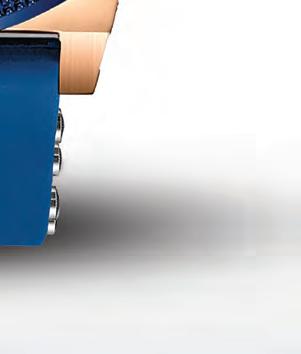




You want AI Routing! Let TZ MAPS with AI Routing make route planning a snap. Don’t take our word for it. Scan here to see for yourself how easy it is!

















You want AI Routing! Let TZ MAPS with AI Routing make route planning a snap. Don’t take our word for it. Scan here to see for yourself how easy it is!











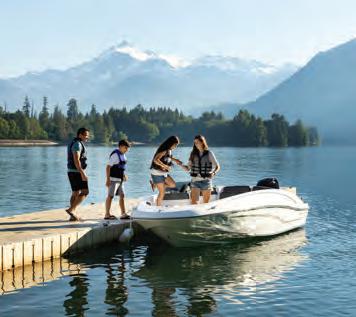






Embarking on the open water is an exhilarating experience, flled with the promise of adventure and relaxation. Whether you’re a seasoned sailor or a weekend cruiser, protecting your vessel with proper insurance is not just a choice—it’s a necessity. Explore the reasons why every boat owner should prioritize boat insurance for a worry-free voyage.
The open water can be unpredictable, with unexpected storms, collisions, or other potential accidents. Boat insurance can give you fnancial protection if there is damage to your vessel, providing coverage for repairs or replacement.
Accidents on the water can result in damage to other boats, docks, or even injuries to passengers. Boat insurance offers liability coverage, which can pay for damages or injuries you’re liable for while boating, up to specifed limits, and lawsuit costs if you’re sued. This includes damage you cause to another watercraft or if someone on or near your boat is injured and you’re found to be legally responsible.
Unfortunately, boat theft and vandalism are realities that boat owners face. Boat insurance has comprehensive and collision coverage that can protect you against events outside of your control, including theft and vandalism.
Accidents on the water may lead to injuries for you or your passengers. Boat insurance offers a range of optional medical payments coverage limits, helping to cover medical expenses if you are in an accident or someone is hurt on your boat, regardless of fault.
If you fnanced the purchase of your boat, most lenders require insurance coverage to protect their investment. Having boat insurance not only fulflls these requirements but also gives you peace of mind knowing that your fnancial interests are safeguarded.


Some water municipalities and marinas may require proof of insurance for docking or accessing certain areas. Boat insurance allows you the fexibility to explore different destinations without worrying about entry restrictions.
Emergency towing and assistance
Progressive boat insurance can include optional Sign & Glide® On-Water Towing coverage. If your boat is disabled or breaks down on the water, Sign & Glide® pays for on-water towing, jump starts, soft un-groundings, and fuel delivery.
Wreckage removal
If your boat sinks, Progressive boat insurance will cover the cost of removing your boat from the water (if removal is legally required).
Investing in boat insurance is not just about protecting a valuable asset; it’s about safeguarding the memories, experiences, and joy that come with your on-water adventures. Don’t let unforeseen circumstances disrupt your journey—navigate with confdence, knowing that Progressive boat insurance has you covered. Ensure a smooth and worry-free voyage, because when it comes to your boat, peace of mind is the ultimate luxury.
Scan to get a quote in as little as 4 minutes
learn more.




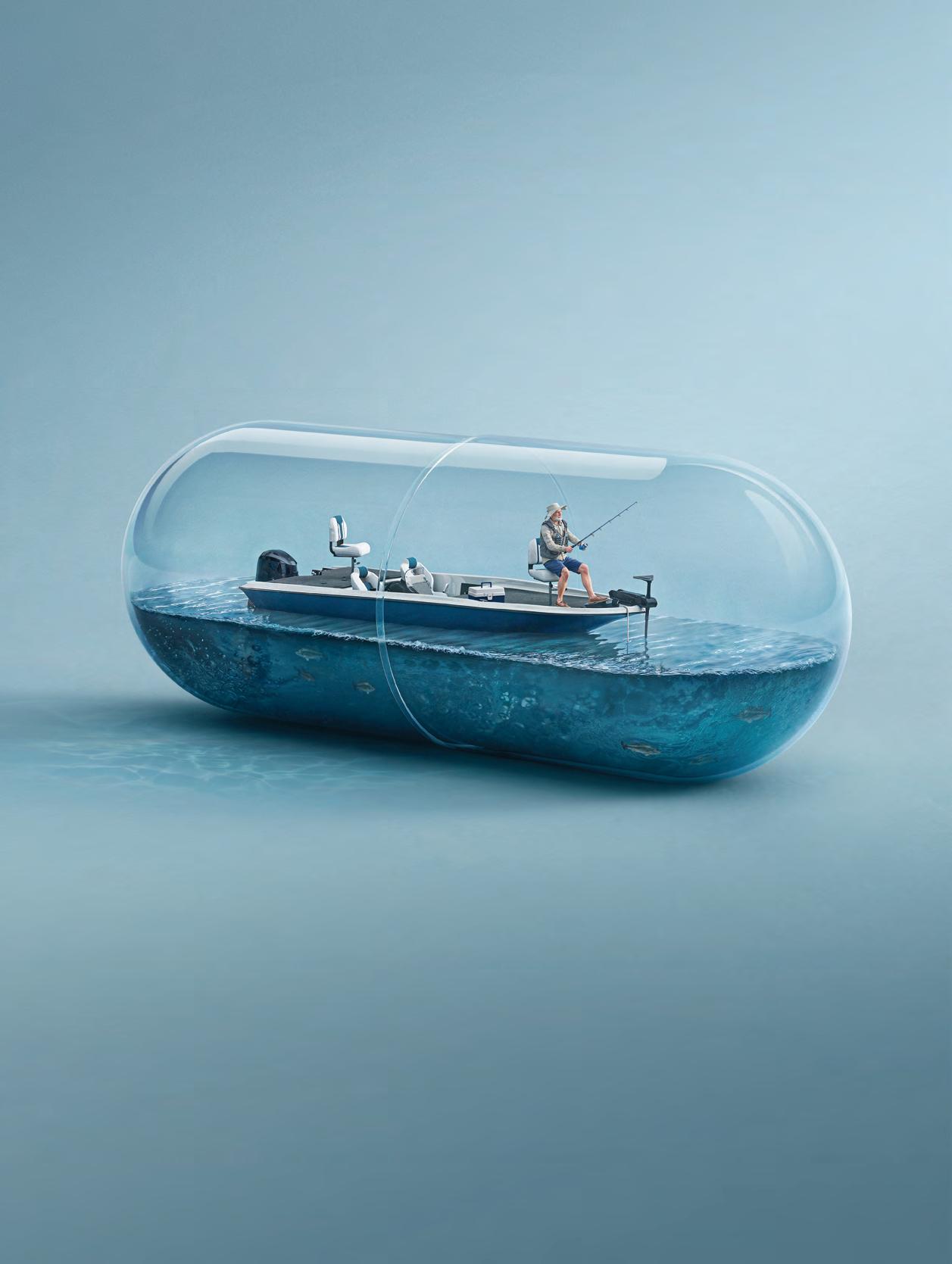
















Tim Barefoot
Since the endangered, gag grouper and American red snapper are o!-limits this month, it would be a good time to go deeper and/or change up your tactics to target di!erent species. For example, go ahead and catch your three scamp/red grouper combo, then switch over to smaller baits and smaller circle hooks on chicken rigs to target beeliners, trigger sh grunts and seabass.
I would strongly suggest taking live pin sh from the marina for scamps and red grouper. is will accomplish two things. One, it will weed out a bunch of trash bites from smaller snappers and other bait steelers because only the sh with a mouth large enough to eat the pin sh will give it a go, and two, it will catch the older (larger) sh that o en will not bite a chicken rig and cut bait. e chicken rig with a bank sinker, and the bank sinker with a triple swivel, leader and hook have been the industry standard for many decades, but these sh have evolved and have become savvy to this method, in my humble opinion. is is the reason the Decoy Jig system is so e!ective. ey’ve never seen anything like it and it’s a clever disguise of what is really happening; the weight and bait are in one clean package, attached by a piece of %uorocarbon.

ere is one downfall to shing live pin sh on the Decoy Jig—it will de nitely get the shark bite. Sharks, like many other sh, are hardwired to eat this struggling bait attached to something else they like to eat, like a squid or a crab.
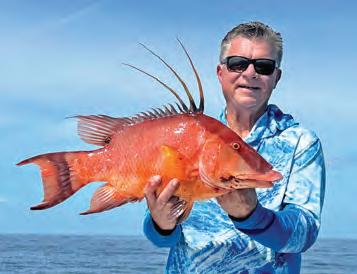
ere’s another sh I didn’t mention earlier, but this is a good time of year to target hog sh. ere are many schools of thought when it comes to catching them. Many say the chicken rig is the ultimate and, yes, there have been a lot of hog sh caught on your standard chicken rig. But this is a pretty wily species, and hard to catch for a number of reasons. Not only are they hard
to get to bite, but they pull HARD! You have to have seriously strong connections because they will test every part of your tackle. ere’s one more sh that is almost as good table fare and that’s the white jolt head porgy. Same tactics, same everything; you just gotta nd them. ey are beyond delicious. You can troll all you want, but I’ll spend my time bottom shing for the best groceries and keep the light line out back for any wahoo, dolphin, kings or tuna that may cruise by. It pays dividends to jig up live cigar minnows and live sardines on the Sabiki or just purchase them for the light line. August and September are the months that wahoo, yellow n, dolphin, sail sh— you name it—are everywhere inshore following big schools of bait, and a live cig or sardine will de nitely get the bite. I would de nitely keep a live pitch bait ready on a circle hook on piece of %uorocarbon for the sail sh that’ll swim by the boat. Keep the thumping music, cooler slamming loud everything to a minimum if you want to have a shot at getting some of these sh to swim up to the boat. Fact: You’ll see more sh near the boat when you’re quiet, otherwise they will keep their distance and you probably won’t see them, and they’ll have their guard up if they do get near the boat.
Go on, get down to the bottom or at least lower in the water column for the best groceries and keep a pretty live bait out back on the lite line for a great day of catching...not shing.
Check out more from Tim Barefoot at barefootcatsandtackle.com.

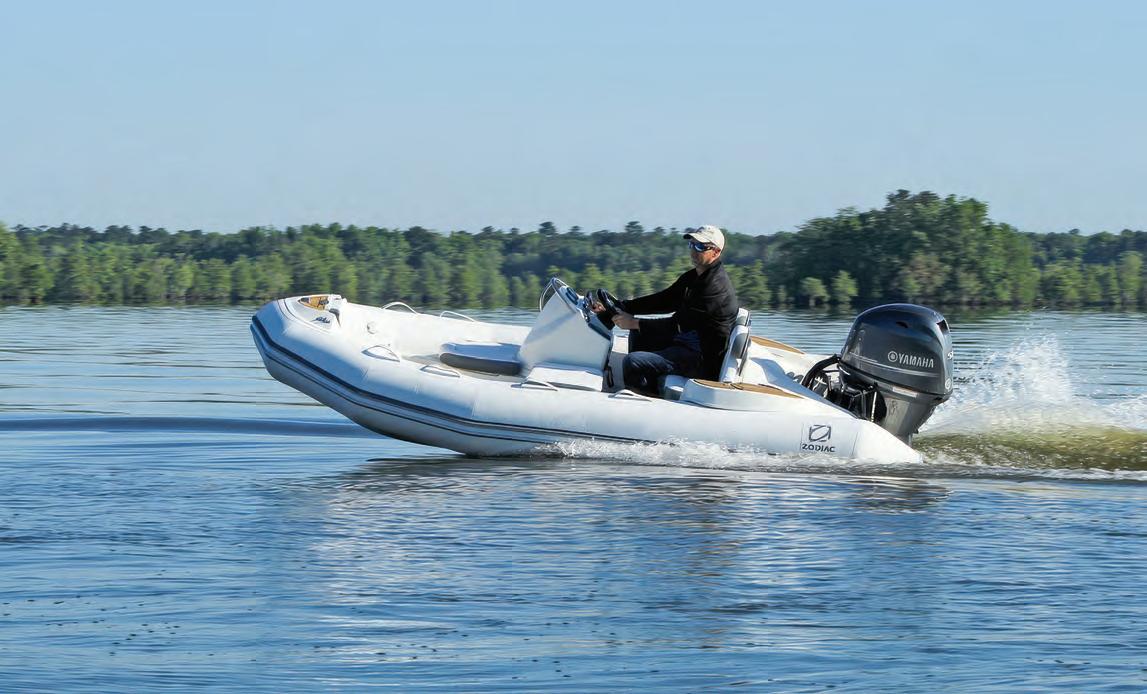
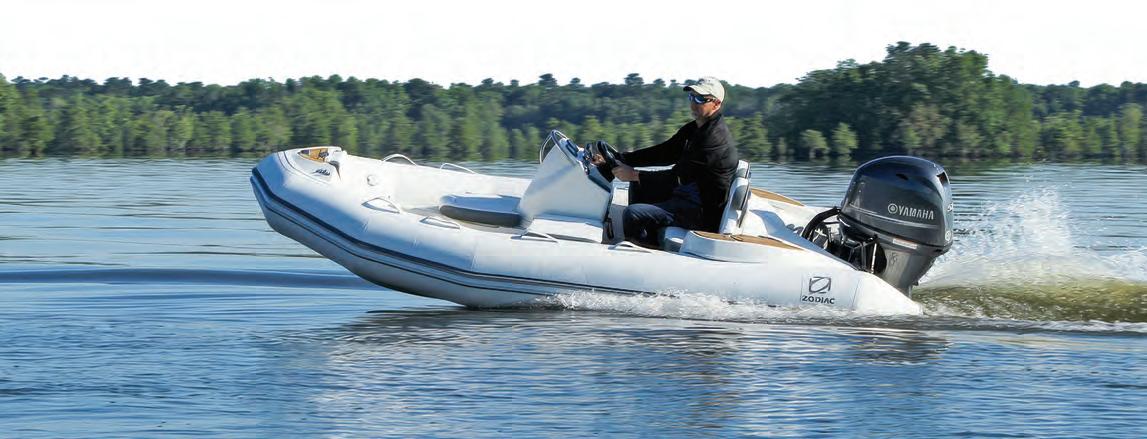

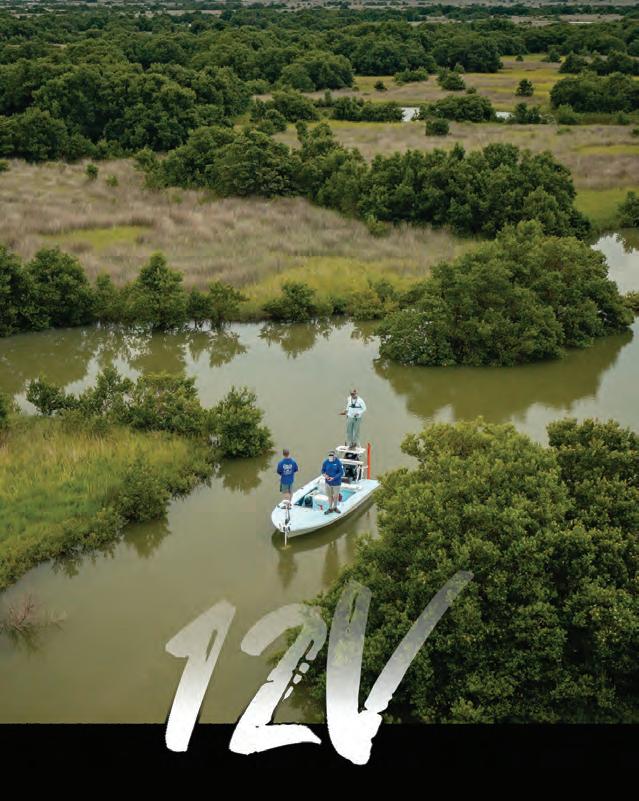
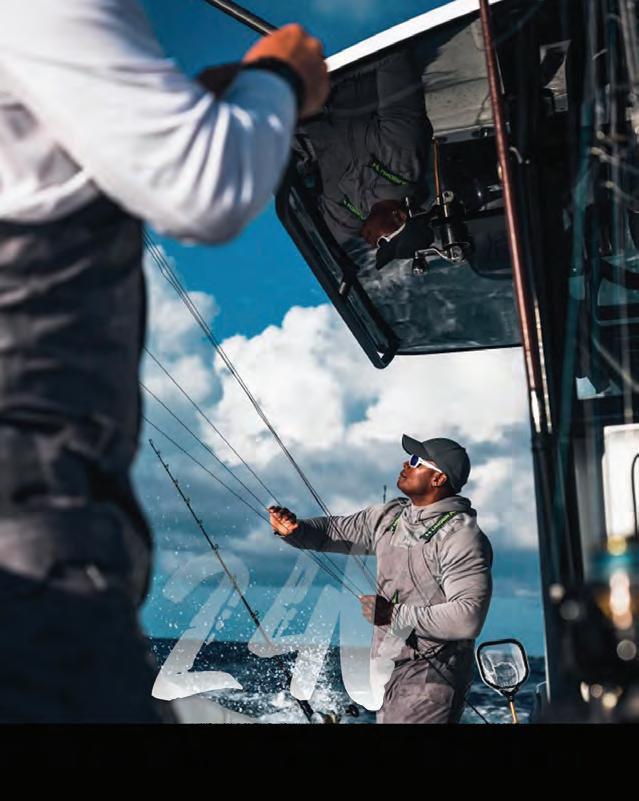




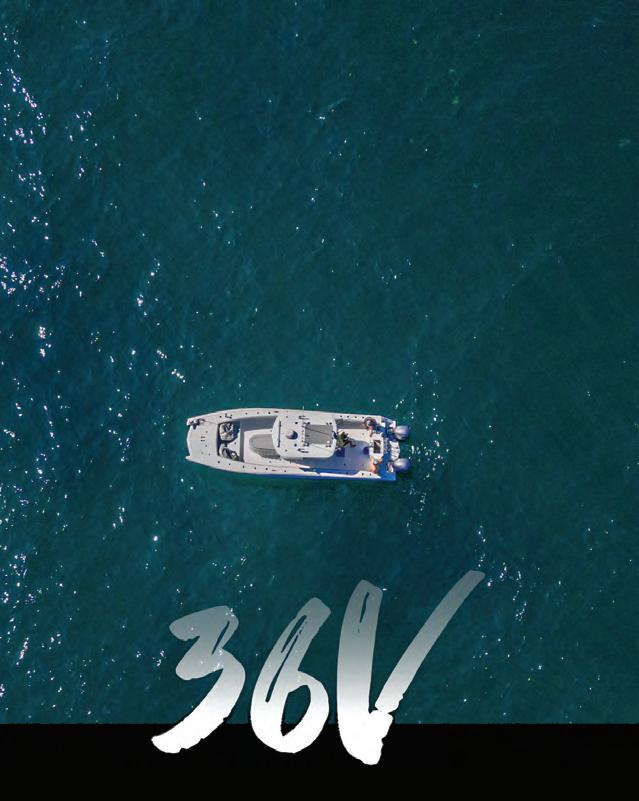




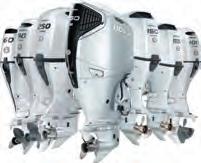
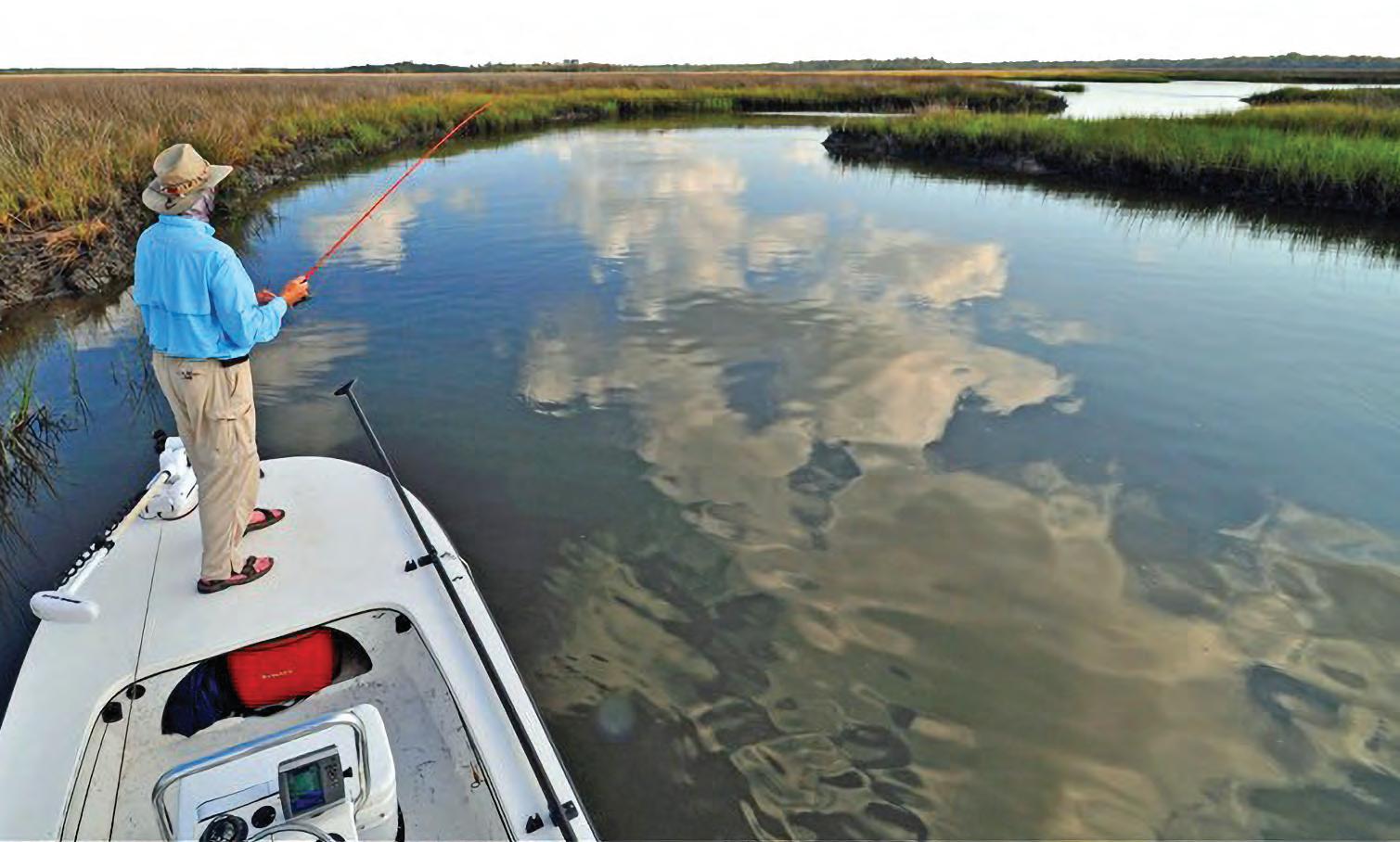
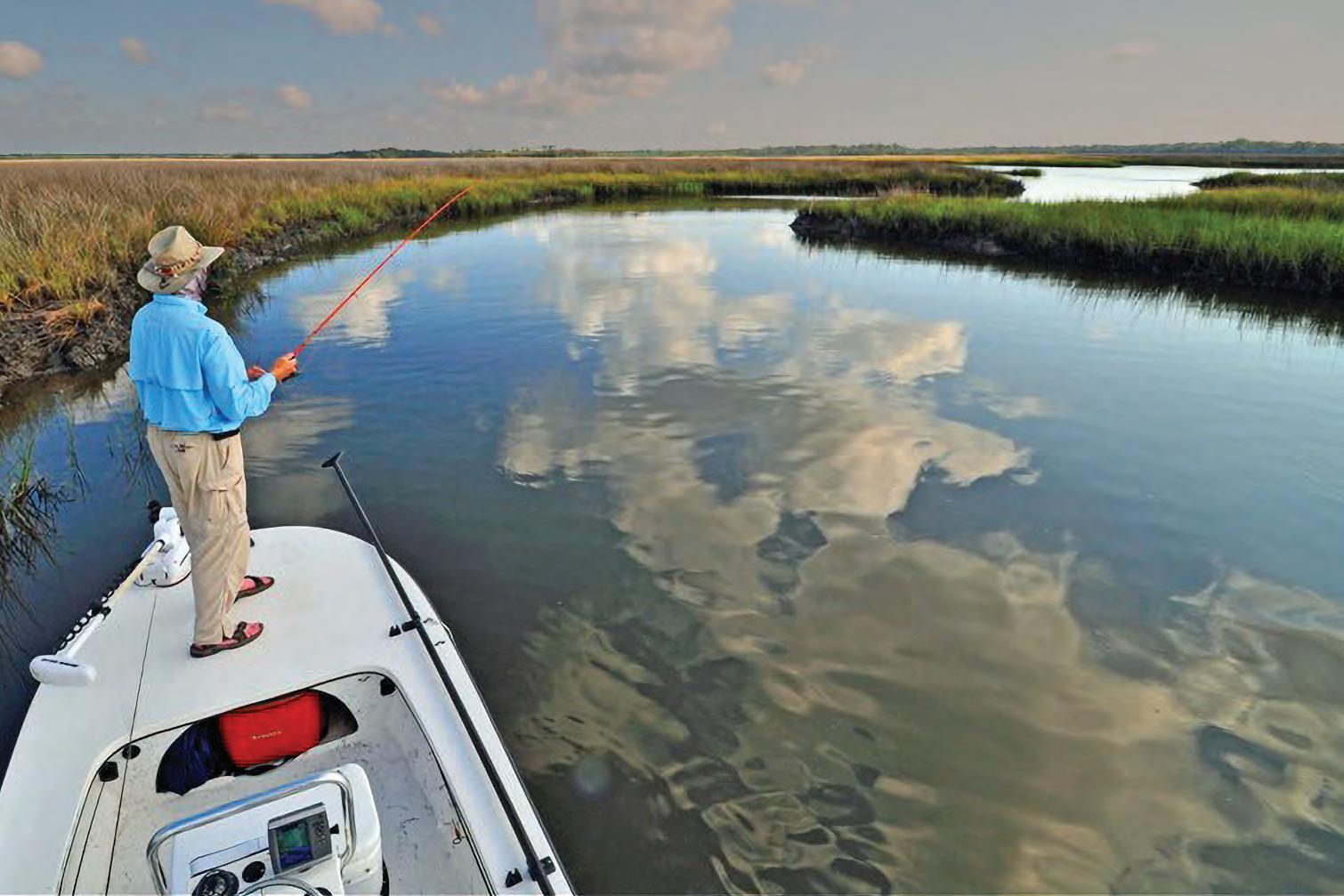
By Joe Woody
Somewhere in McDowell County, North Carolina, where the Blue Ridge Mountains lean in close and the rivers run clear enough to drink, there’s a place where sh outnumber people, and cell service is more suggestion than fact. It’s a land of steep gorges, sparkling lakes, and waters that curl through the woods like they have secrets to keep. Welcome to the triple-threat shing grounds of Lake James, the Linville Gorge, and the Catawba River — tucked into a county that doesn’t make much noise but delivers in trout, bass, and backcountry beauty.
If you’ve never heard of McDowell County, don’t worry — that just means the sh haven’t heard of you either, and your odds are still good. Whether you’re a dry-%y purist with a hip pack and a “River Runs rough It” complex or someone who likes to toss worms near pretty rocks, this corner of the Carolinas has a spot for you. Bass are stout and sassy. Trout are plentiful, and they have attitudes to match. So gas up the truck, tie on something that worked last season, and head for the hills. e shing is great, the views are even better, and McDowell County is ready to welcome you — even if the trout aren’t.
Lake James is the area’s big-water bu!et. is 6,800-acre reservoir between Burke and McDowell counties o!ers smallmouth and largemouth bass, walleye, crappie, bluegill, hybrid striped bass, and cat sh. Spring and early summer bring aggressive smallmouth to the surface from April to June. Tossing a Pop R or a Zara Spook at dawn can trigger explosive strikes. Crappie move shallow in May and June, while cat sh linger year-round, especially from fall through early spring. Bass shing is best around rocky points and submerged trees with crankbaits or so plastics. Walleye respond to trolling or jigging near the dam. If you’re a er cat sh, bring cut bait and patience. Lake James State Park has public ramps, campgrounds, showers, and picnic shelters — perfect for anglers who like their wild with a touch of comfort.
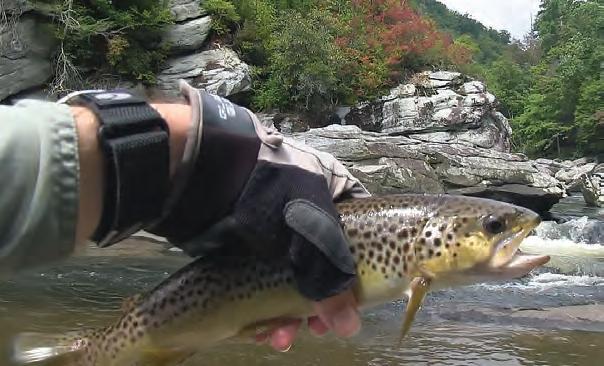
If Lake James is your comfy recliner, Linville Gorge is the rugged Adirondack chair that bites back. Known as the Grand Canyon of the East, this steep gorge is home to the Linville River, one of North Carolina’s best wild trout waters. e upper river holds wild and stocked rainbow, brook, and brown trout. Below Linville Falls, you’ll nd a backcountry adventure with native browns lurking in clear pools. Reaching prime spots requires steep descents, with some trails dropping 1,400 feet. e solitude and scenery reward every blister. Bring light tackle, stealthy casts, and plenty of water. Spring hatches bring trout to the surface, and a well-placed dry %y can tempt a wary sh. Remember your headlamp — climbing out in the dark is no fun.
Below Lake James, the Catawba River %ows cool and clear, sheltering rainbow and brown trout that grow large and wary. Float trips are ideal. An eight-mile dri from Bridgewater Dam to Morganton delivers ri sh. e Joseph McDowell Greenway o!ers piers, canoe launches, and bank access perfect for beginners or families. Streamers and weighted nymphs excel in the tailwaters, while warmer sections downstream attract bass and pan sh.
Wherever you cast, the sh here don’t come easy — but they come honest. And in this corner of the Blue Ridge, that’s the best kind of bite.

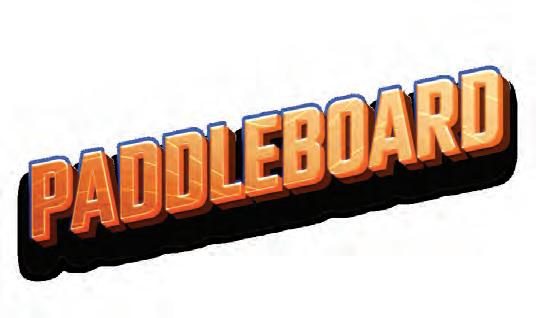
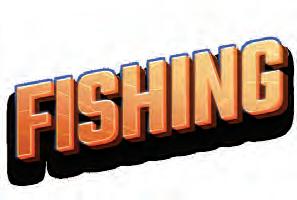



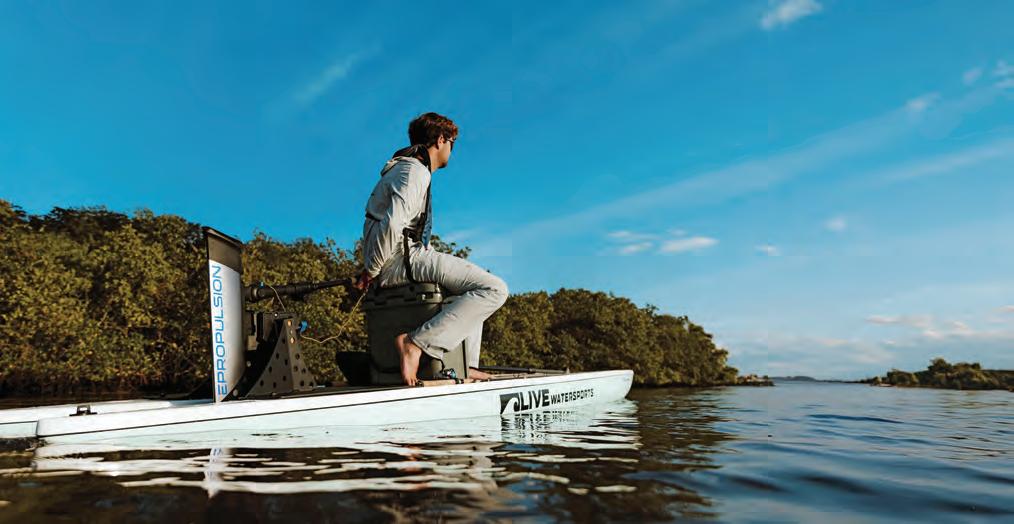






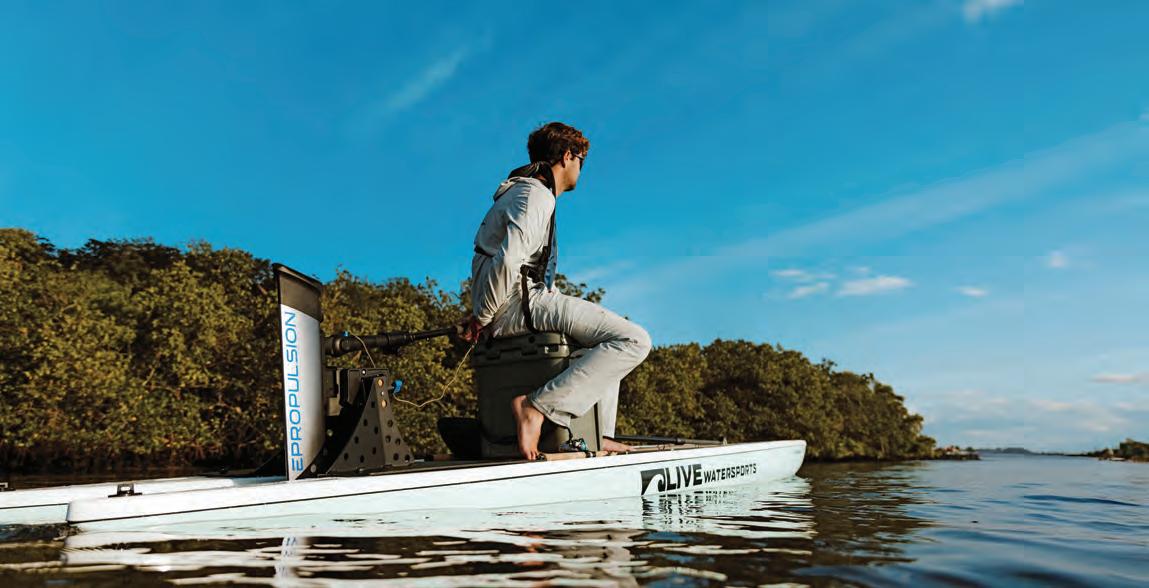





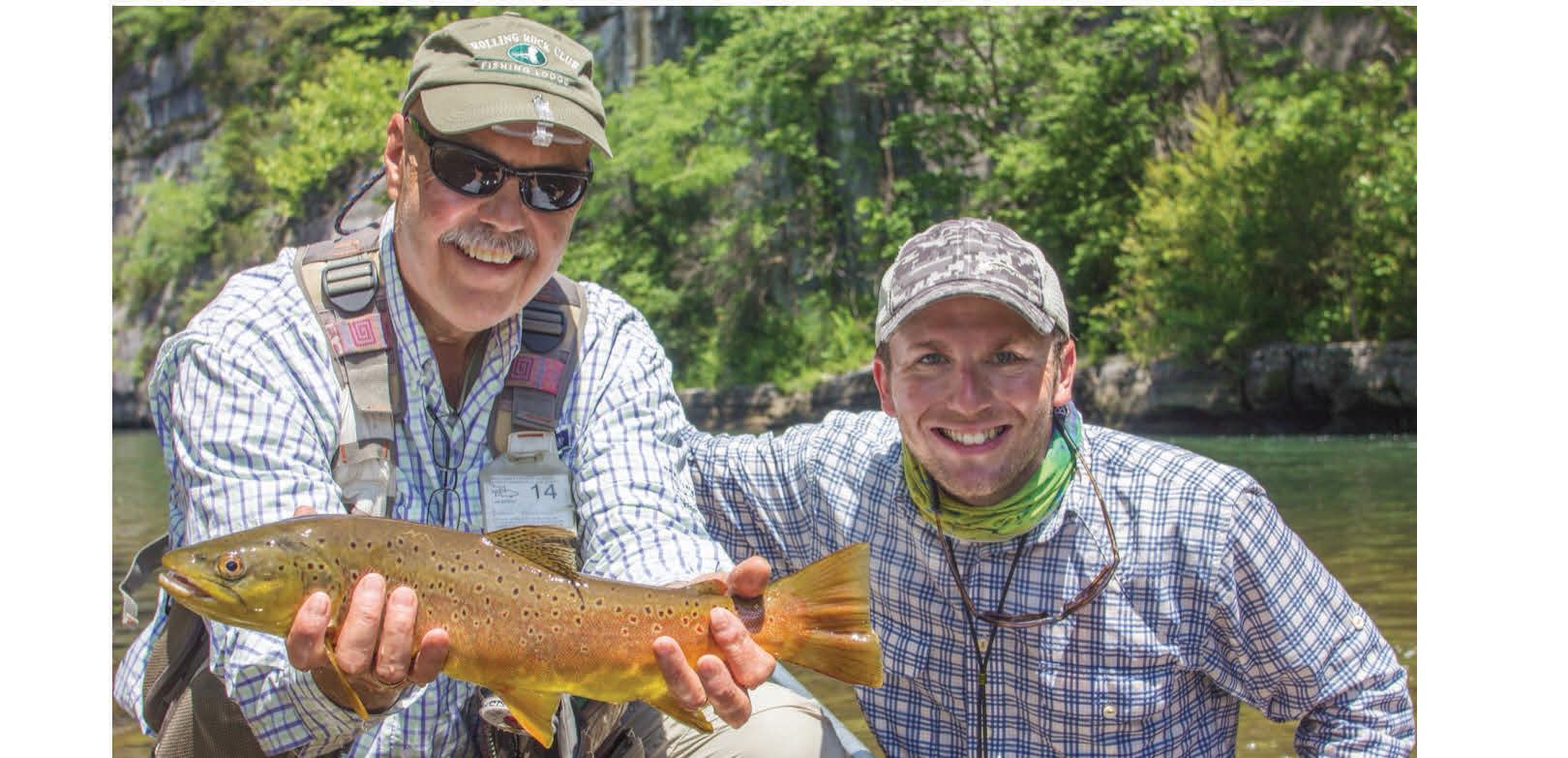




Capt. Mike Smith

Black drums, aka “Big Uglies,” are a super fun sh to catch. It doesn’t matter if they are 18 inches weighing two pounds or 5 footers weighing 90 pounds. ey put up one heck of a dragpulling ght once they gure out that they’re hooked.
Black drum can be found in inlets, saltwater estuaries, bays, river mouths, brackish creeks and especially anywhere in close proximity to oyster beds as they love to eat oysters, clams, crabs, shrimp and bait sh. ey are o en in huge schools and will stay in one spot for a week or so if there is a lot of food for them and not a lot of predators, which means that you can catch dozens of them when the bite is on.
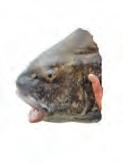
My favorite way to target “big uglies” is on the incoming tide, in shallow estuaries, less than 3 feet deep. at is when you can see them tailing as they root around oyster clumps for crabs and shrimp. A well-placed shrimp or crab o!ering will get their attention very quickly. Make sure you have enough weight to get it to the bottom so they can nd it.
on them. De nitely sh the older docks with the most stu! growing on them. ese docks pilings will attract the most crabs and shrimp to them. Old dock pilings are like grocery stores for black drum. When I sh the docks for black drum I usually have one of two baits with me. Live or frozen shrimp or a scented shrimp jig. ose are my goto baits for drum around the docks. Real shrimp works the best, but the scented jigs are pretty good too. A shrimp rigged with a small split shot is how I usually target black drum. Just cast it to where you think the sh are and wait for the hit. If you are shing with a scented shrimp jig just bounce it slowly on the bottom as you reel it in. It is similar to the way that you would sh for a %ounder. e slower the better.
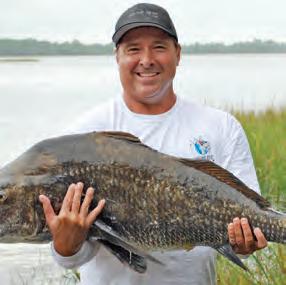
Black drums have four nostrils, and their sense of smell is amazing, so the stinkier the bait, the better when targeting these sh. A great arti cial bait is the Berkely Gulp shrimp on a 1/8 ounce jig head. You can just cast it to the sh and let it sit on the bottom and wait for them to nd it. However, if you give it a bounce or two you will usually get their attention much more quickly.
Another great place to target “big uglies” is around docks. Dock pilings tend to have lots of oysters, clams, barnacles and sponges growing
For surf shing anglers, large schools of black drum typically work their way up and down the beaches in the cooler months feeding on crustaceans. Use a beefed up pompano rig, jig or sh nder rig and place them in front of the schools approaching. Long casts are o en needed, so be sure to have plenty of line capacity on your surf shing reels when targeting the large ones. Not to mention, once you hook into a big drum the drag is going to go screaming! You’ll want anywhere from 20-50 lb. main line for your best opportunity to land one.


Black drum make for a tasty dinnertime treat, but I wouldn’t suggest eating the big ones. ey are always full of worms. I nd that the best ones for eating are 28 inches or less in length.
I caught the black drum in the picture above on a dead shrimp. It was about a 50 pounder and took 30 minutes to get it in. I saw it tailing next to an oyster bar.
Capt. Mike Smith, owner of Fish Your Ass O Charters, is an inshore shing guide who has been shing the inshore waters, oyster bars and grass ats of Florida for more than 40 years. Reach him at (561) 339-2317, email: contact@ shyourasso .com or visit shyourasso .com.
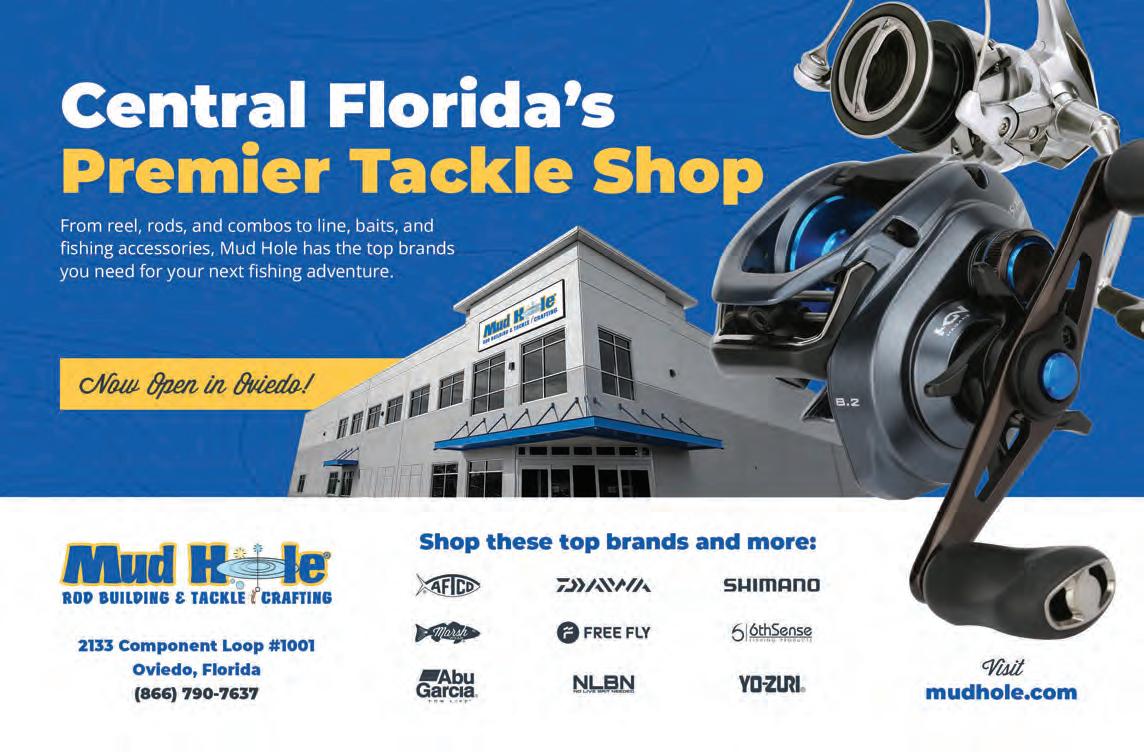


By Phillip Hutcheson
Catching a two-foot-plus brown trout is quite an exhilarating feeling on the boat. Especially on the nation’s most challenging tailwater to fish, the Chattahoochee River. Would it surprise you to learn that not only did we catch one but two 24-in-plus trophy Chattahoochee River browns? This is how it happened with one of my closest fishing partners.
Dave, my fishing partner, is a retired former Vietnam helicopter repair pilot and former teacher and generally one heck of an American and family man. We started fishing together the year prior, after talking extensively about the river. The turnover on the river was when we started fishing together, but this story happened a couple months later. This January day was exceptional.
After grabbing some Pub Subs for lunch and making our run up to the dam, we got into the brown trout immediately. Our first float back from the starting bridge had brought many good fish to hand as we floated down past the islands. We were completely content to catch a lot of fish that day and started to see some bigger fish show up, so we ran back up to the bridge and restarted our float.
As we came around the bend from the bridge and into the flat, the water was gin clear and moving very steadily, or as another friend

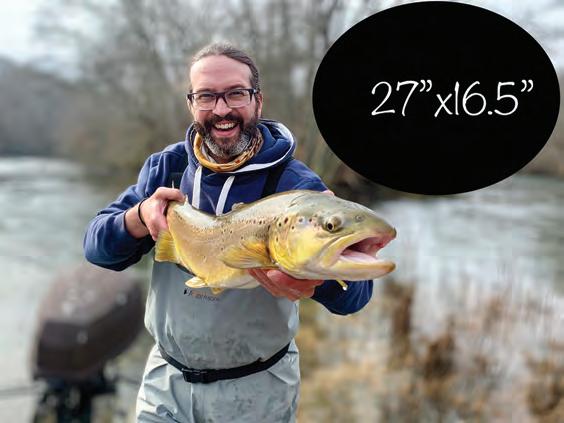
referred to it as ‘very western’. I knew immediately what he meant as the higher water at that location flows much more quickly than normal and as a result, you have less time to react so you have to stay sharp. We caught fish after fish above two prominent log jams that are mid river.
As we floated by and towards river left on the river, there were several ridges of rock that are exposed in a mostly downstream trending direction. There are deep pockets and eddies all along these ridges as a result. I made my cast nearly perpendicular to the rocks and started working my presentation back. Pause… Slam! And I am on with a big fish! As I mentioned earlier, Dave my partner is fishing away. I yell,”BIG fish Dave, need the net!” No response… I yell louder this time and Dave is able to hear me over the moving water.
As I am fighting the fish, Dave is working to free the net, but the knot holding it in place would not come free until Dave gave it some slack. Meanwhile this GIANT, mean, big brown hen is ripping drag upstream and also occasionally trying to gator roll to get herself unhooked, flashing all sorts of wild, bronze and gold colors under the water. Her attempts were unsuccessful, so with some whitewater approaching, I swing the fish over to the waiting net where Dave is able to scoop her up… Success!!!
She taped out at 27 in in length and 16.5 in girth! And if you zoom in on the fish, she dropped one egg. Even in late January we still have brown trout actively spawning somehow! Got her unhooked and some photos and sent her home successfully. I was ecstatic at that point and it was not even lunchtime yet! We floated down to where we floated before and ran back up, high on adrenaline. After stopping for lunch on shore we got back to fishing.
The next float still had me floating on cloud nine and Dave & I were catching tons of browns with a couple of quality rainbows coming to net as well. We got down to our stopping point and headed up for one more float. Which again, we were absolutely just having our way with

MONSTERS continued from page 2
the trout as we floated down, this time running the river left section through some rapids to a flat with lots of downed timber on the river left side. We had affectionately started referring to it as the ‘Land of Giants’ after moving some large fish on a couple of prior trips.
It did not disappoint either as we floated into the area, Dave and I both cast into the timber with the emerald-green waters swirling about. I did not have much more than chasers on me, but as I looked up and started tracking Dave’s presentation coming down along a log, perfection happened. It was slow motion as the big hen came out and engulfed Dave’s presentation.
I immediately went for the net as Dave was fighting the fish and using the trolling motor to guide us down one of the sketchier parts of the river with a fair amount of whitewater. We floated over one wave, Dave still fighting the fish. As we approached the next whitewater wave, the fish flipped sideways and came up to the surface nearly to the point
No clue we would have this kind of day, but it is possible if you work for it
Dave could get her on top but with the wave, it did not work. I knew I had a very narrow window to net her and as Dave swung her down towards me, everything fell into place perfectly and she was in the net! Not Dave’s largest Hooch brown, but at 25.5in she was no slouch!
We grabbed some photos and a release video of her and sent her
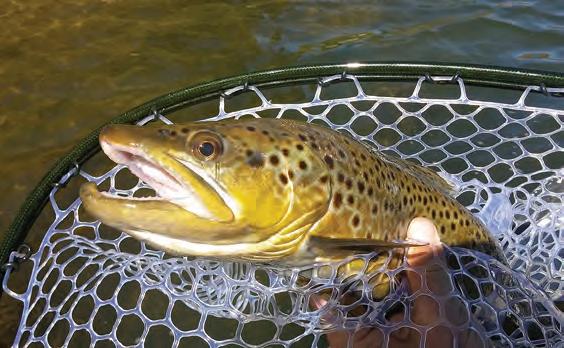
back home as well, both of us giggling as we watched her swim off fast and powerful. We had just caught a 27in and a 25.5in set of hen browns on the most challenging tailwaters in the USA! From doing research and talking to my friend Chris, with River Through Atlanta, prior to us catching these fish, it may have been around a decade since a feat like this had occurred on the Chattahoochee river. Is it impossible to do? Obviously not, but there was a large amount of man hours invested to make this happen.
Some folks like to ask if the Chattahoochee river is a true trophy brown trout river. I tell them it certainly is, but due to all the factors involved here, it makes it very tough to catch fish like these consistently. Only for sure way to know is to join us out on the river and see what we can find. Dave & I had no clue we would have this kind of day, but it is possible if you work for it. Just give us a call and see how we can help get you on one, if not Twin Monsters of the Chattahoochee River.

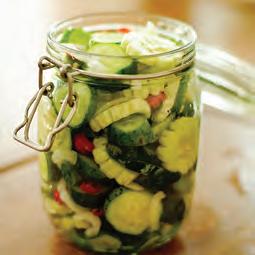


By Ben Bailey
Trout anglers are about the most optimistic people I know. I figure it probably has something to do with the cold water around their feet pulling the heat away from their brains, or maybe just the tranquil beauty of the trout streams that evokes good and pleasant thoughts. It seems to me that Jesus Himself had a tender spot for anglers. He had several in his inner circle and, if you remember, the morning He called them ashore for breakfast He already had fish baking on the coals. I have often wondered how He caught them. Was it a dry fly or nymph? Or did He simply command them to flop up on the bank? But before He did that, He directed a whole boatload into the disciples’ net. They didn’t need all those fish for breakfast. That, my friend, was an angler’s dream made to come true by the God of Creation.

What I experienced Memorial Day 2009 was, in many ways, very similar. Joe Woody and I had canoed in from Cable Cove the day before. We camped at Proctor, enjoyed a pleasant supper and campfire, and rose early, anticipating a good day’s fishing. The weather was perfect but then, there’s no such thing as bad weather on Hazel Creek. Joe is by far, the better angler of the two of us, but we both share a like-mindset to fish the headwaters and go where few people ever go. With that in mind, we set out up the creek, headed for Sugar Fork or Bone Valley or who knows,
maybe Calhoun. We stopped occasionally to fish the most irresistible places.
Lunchtime found us at Sawdust Pile. We sat down on a log and enjoyed our crackers and hickory smoked tuna. It had been a very pleasant morning. Joe had caught a couple of 8-9 inch rainbows that he had squirreled away in a small fanny pack for our supper. I had not caught any keepers but had still thoroughly enjoyed myself. It’s called “fishing” for a reason! After lunch, we continued up the creek, still more intent on the headwaters but unable to pass up those dark holes, pocket waters, and whitewater swirls.
Eventually, we came to what is reverently referred to, in the Hazel Creek language, as the dark hole, or by some, the brown hole. It is a place of incredible beauty, probably 200 ft long and 75’ wide and 10 ft deep, and full of churning, rolling, sweeping whitewater that fans out into the deep, dark hole which is protected on both sides by thick rhododendron and laurel. Only the bottom one-third is wadable, the rest a haunted place, where the faint-hearted need not go. But yet, the dark waters beckon and few can resist.
Knowing that, I could not wade nor could I cast very well in the thick
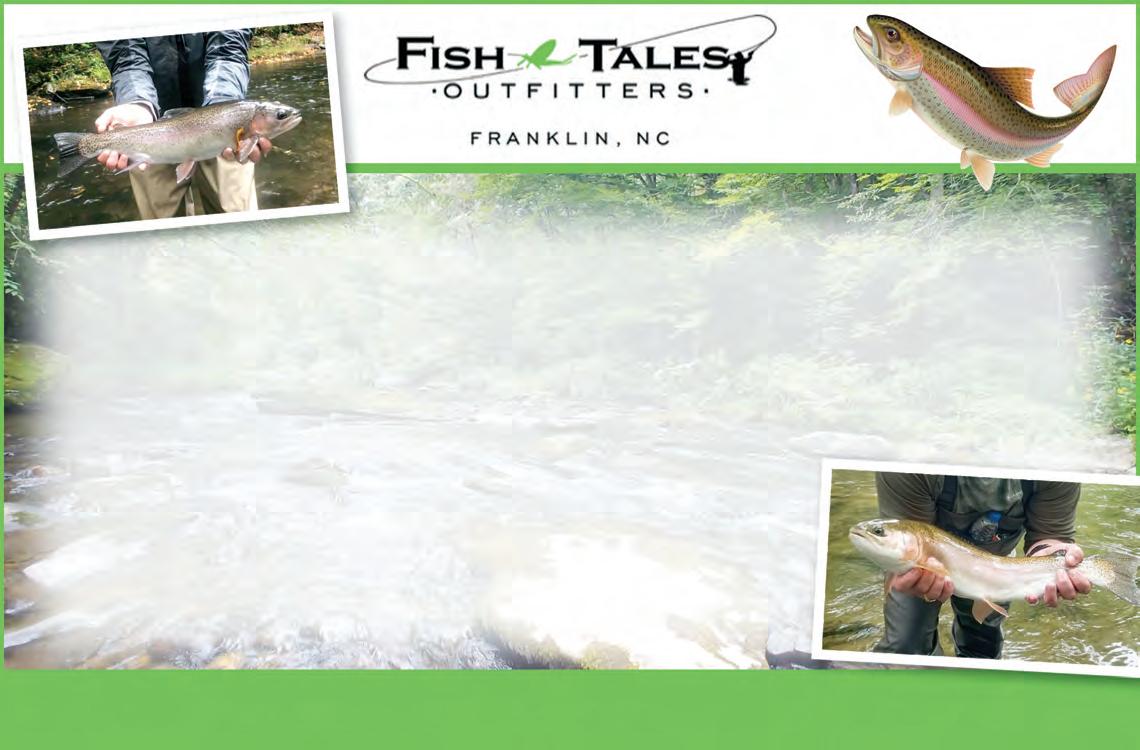
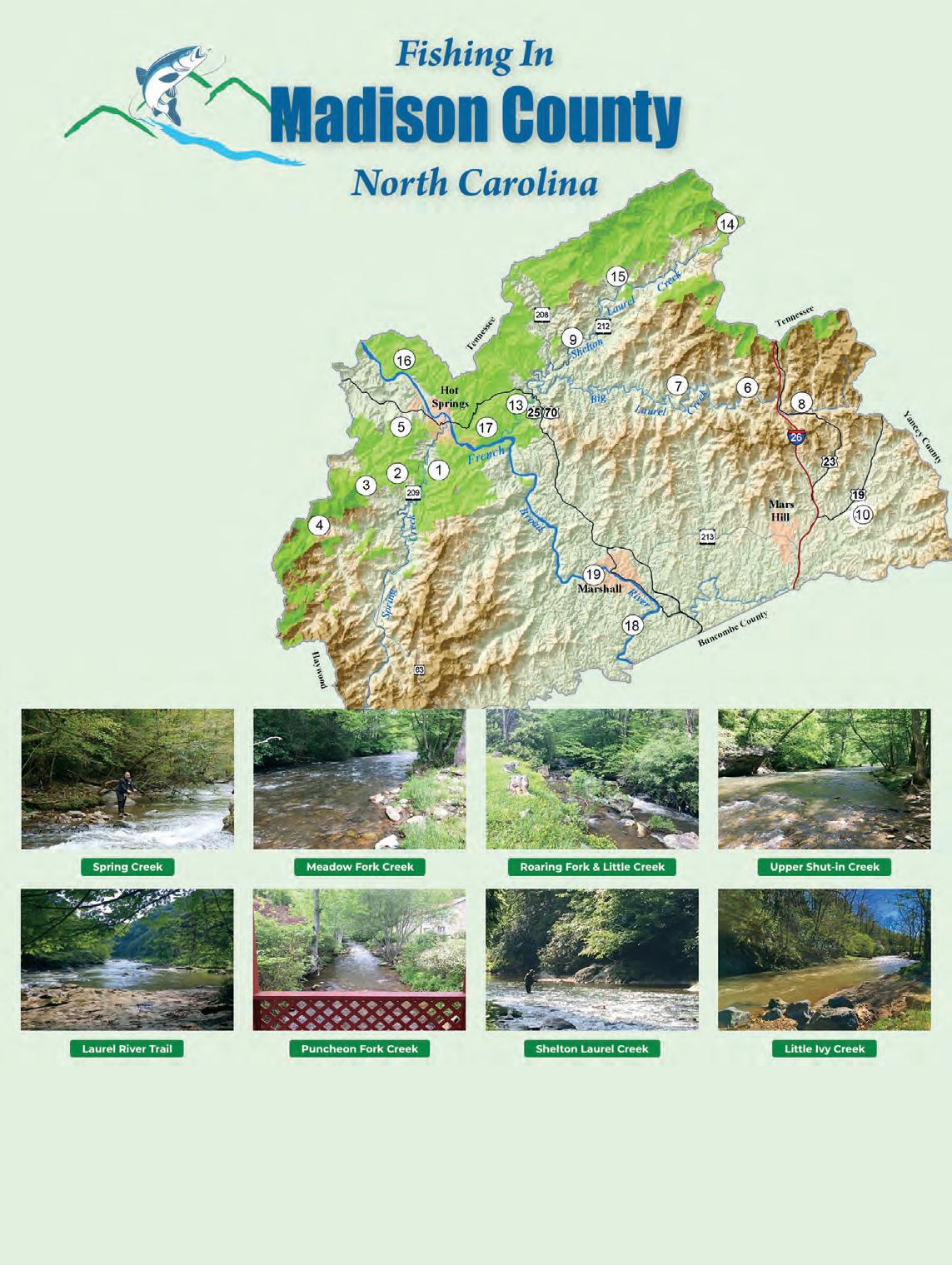
rhododendron. I took my fly rod off and put on a small spin cast reel with a small gold leafed spinner. I fished up about half way by casting between rhododendron limbs but eventually, or inevitably, I overshot the creek and hung up in a laurel bush on the other side. Not wanting to disturb the water, I broke the line. To my dismay, my tackle box yielded only an old catch-man spinner that I had probably had for 20 years. I had to add a couple of lead weights to it so that I could even cast it over the creek. I carefully fished the rest of the hole but, as I had done many times before, came up empty-handed.
I climbed up on a rock where Joe had been fly-fishing the churning whitewater with the same result. “Try that spinner there,” he said, “then we’ll go on up to Sugar Fork.” I cast across the foaming torrent and began to reel the spinner back through the rushing water. I felt a light “bump,” then my line tightened. I lifted my pole to set the hook and hollered to Joe. “I’ve got one!” Joe took off his fanny-pack and unzipped it saying, “one more for supper.” About that time, my rod bent almost to the water and the drag started slipping. I hollered back to Joe saying, “I don’t think this one’s for supper!” I played him for a few minutes in the swift water. I knew I had a big fish but I still didn’t know how big. Finally, he tired a little and I was able to pull him to the calmer water. I saw a flash of ivory under the water, which told me that I had hooked a big brown.
Just as that registered in my mind, the water erupted as he danced on his tail and shook that massive head from side to side trying to throw that cursed thing that held him captive. Back down he went, back to the safety of the swift whitewater. I dialed back the drag, trying to prevent it. My pole bent double as he swam for the bottom. I looked at Joe who, by this time, had lost all control of his lower jaw. It hung open like a broken hinge, unable to close itself. His wide eyes darted back and forth from the water to me, wanting to speak but somehow unable to. I looked back
to the water just as the fish made another frantic surge and, as it did, the pedestal of my reel just broke off, falling into the water. I could feel the line slipping through my fingers as the big brown sought his freedom. Instinctively, I wrapped the line around my hand, once again, halting his escape. Joe jumped into the water and retrieved my broken reel. Somehow, I still don’t know how, I held the reel and pole and continued the fight. Finally, I was able to pull the exhausted brown into the calm water and up to the rock where we stood. Joe jumped down in the water and slipped a stringer through the big brown’s mouth before removing the now bent and mangled lure. I picked up my prize and held it in my arms. I had won the battle, but it had been a challenge!
This was a noble creature that I had been privileged to do battle with. He did not belong on a wall- he belonged here in the dark hole. I gently placed him back in the water and watched as he angled, once again, for the protection of the whitewater and the depth of the black hole. I marked his length on my rod…28 inches it measured when I got back to my truck. We went on that day up to Sugar Fork and caught other fish, enjoying ourselves to the fullest, but if I never caught another fish, the big brown from the dark hole on Hazel Creek was enough. I was blessed. It was a gift from heaven, just as the boatload was to those disciples long ago.



By Ronnie Parris
Hey folks, as I write this I’m longing for colder temperatures. This heat is not for the faint of heart. Through it all, fishing has been good this year. I’ve had the luxury of jumping from lake to lake according to the bite, and creek to river, trying to set up for the best success.
The two fish in the pictures are truly amazing walleye. The one for which we had a tape to measure was over 28 inches. Both were pigs; both were really old fish and both were caught on artificial lures on a section of the Tuckaseegee River, which will really surprise a lot of people. I always get asked when we see a big walleye in the river if it came up from the lake

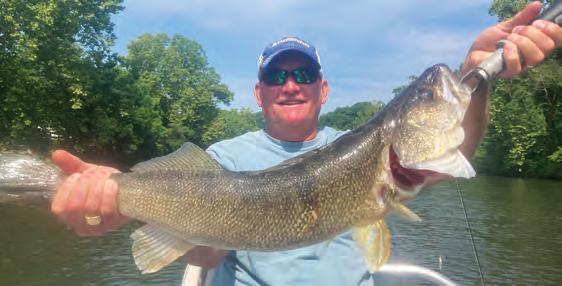
and my answer is no.
I think there’s a hand full of walleye that are raising in the river and never leave. I think they search for the better pools, with oxygen and depth, and spend their life there searching for crayfish and small suckers for their table fare. A good friend of mine, Clint Hurley, used to tell me about catching them on creek chubs he had caught in a trap and fished just the bigger pools for the walleye. Not only would he catch giant walleye, but also huge brown and rainbow trout.
My friend Wally caught the first one pictured when we did a float, right as a hard rain came through. I think this helped us because, as the water got a little stained, some really big trout, as well as this giant walleye, began to feed. With the expertise of both Mark and Wally we were able to trick several well above average fish that day. The second walleye pictured was caught by my good friend Mark.
On this trip the water had just a touch of color, which really sparked a good feeding frenzy, with us putting several nice rainbow and brown trout in the boat, as well as two nice walleye. I won’t name the lure we were
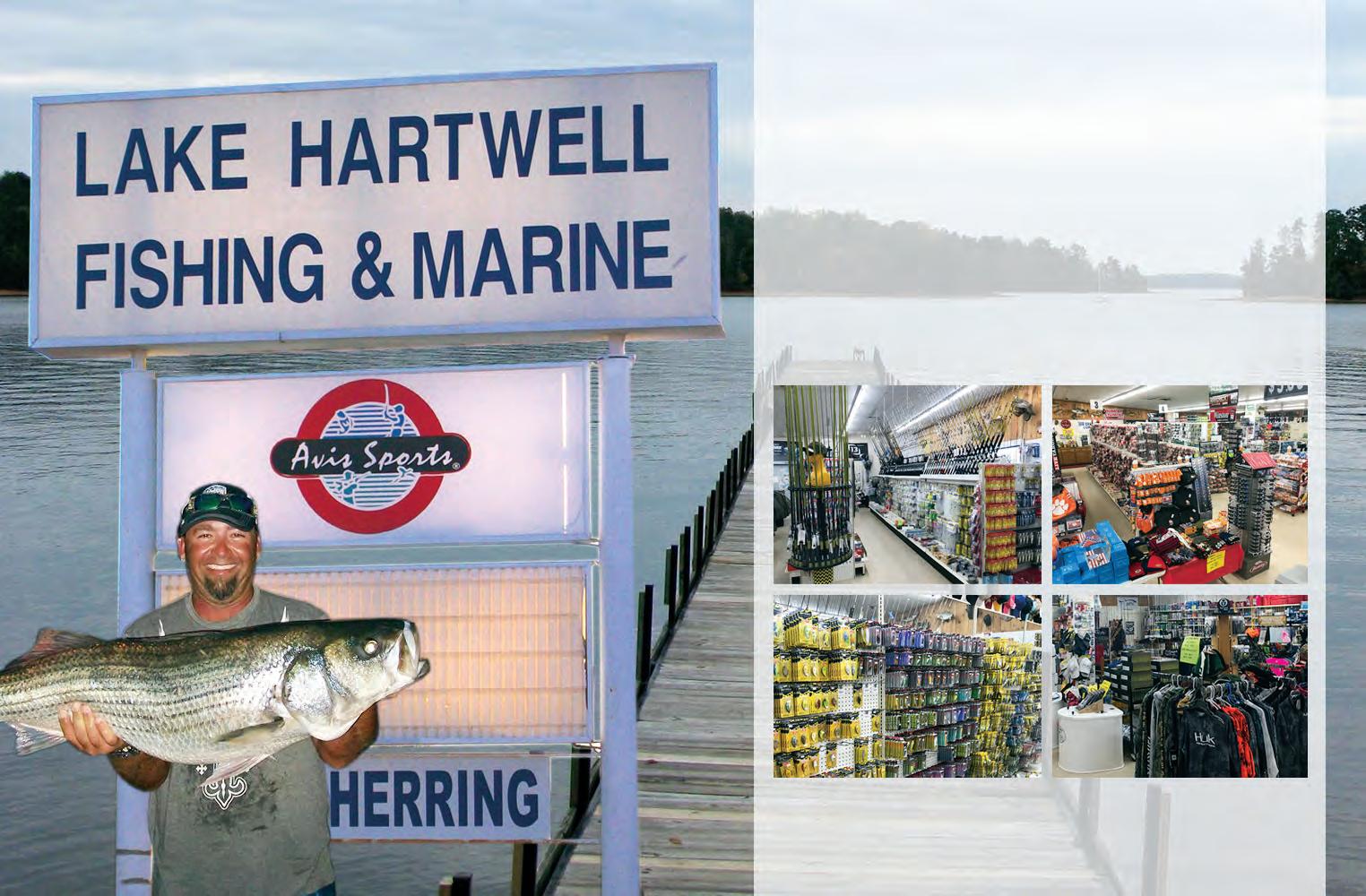

By Daniel Bowman
The familiar quote “There’s gold in them thar hills” is often remembered as a humorous line from Saturday morning cartoons— thanks to characters like Yosemite Sam—but few realize that this phrase actually originated right here on the steps of the downtown Dahlonega courthouse over 175 years ago. At the time, it was a plea to local gold miners to stay in Dahlonega rather than head west to California, as Georgia’s gold rush began to fade and the California rush took off. These days, there may still be gold in the hills of Lumpkin County—but it’s the rainbows, browns, and brook trout that are the true jewels of our mountain streams. Trout fishing in this corner of the Southern Appalachians is a rush of its own for anyone willing to go looking.
Watersheds & Wild Waters
Dahlonega is surrounded by two primary watersheds feeding the main rivers of the area: the Etowah River and the Chestatee River. Both are excellent fisheries. Trout dominate the headwaters, while striper and bass become the main targets in the lower reaches. But today, we’re focusing on trout—and where to go, what to use, and how to make the most of your next visit to the Gold City.
Where to Go
Dicks Creek–
One of the main tributaries to the Chestatee River, Dicks Creek boasts a healthy population of both rainbow and brown trout, thanks to
regular stockings by Georgia DNR and a thriving wild population in the upper reaches.
Directions: From Dahlonega, take US 19N to Stone pile Gap. Stay right on US 19 for about 5 miles. Turn left onto Dicks Creek Road just before Turners Corner. Public access begins about 2.5 miles in, where the pavement ends and the gravel road begins. The best fishing starts below the confluence with Waters Creek and continues upstream.
Nimble will Creek–
One of the most significant tributaries in the Etowah watershed, Nimble will Creek holds both rainbow and brown trout, with a mix of stocked and wild fish. Like Dicks Creek, there’s excellent public access within the Chattahoochee National Forest. Georgia DNR stocks this creek heavily, particularly in spring and early summer, making it a great spot for consistent action.
Directions: From downtown Dahlonega, head west on Hwy 52 (North Chestatee Street). Follow Hwy 52W for about 8 miles, then turn right onto Nimble will Road. Continue 2.3 miles to Nimble will Church on your right. Stay straight on the unpaved Forest Service Road 28-2. After 2.2 miles, you’ll enter national forest land and reach public access to Nimble will Creek.
Continued, see FINDING RAINBOWS Page 18
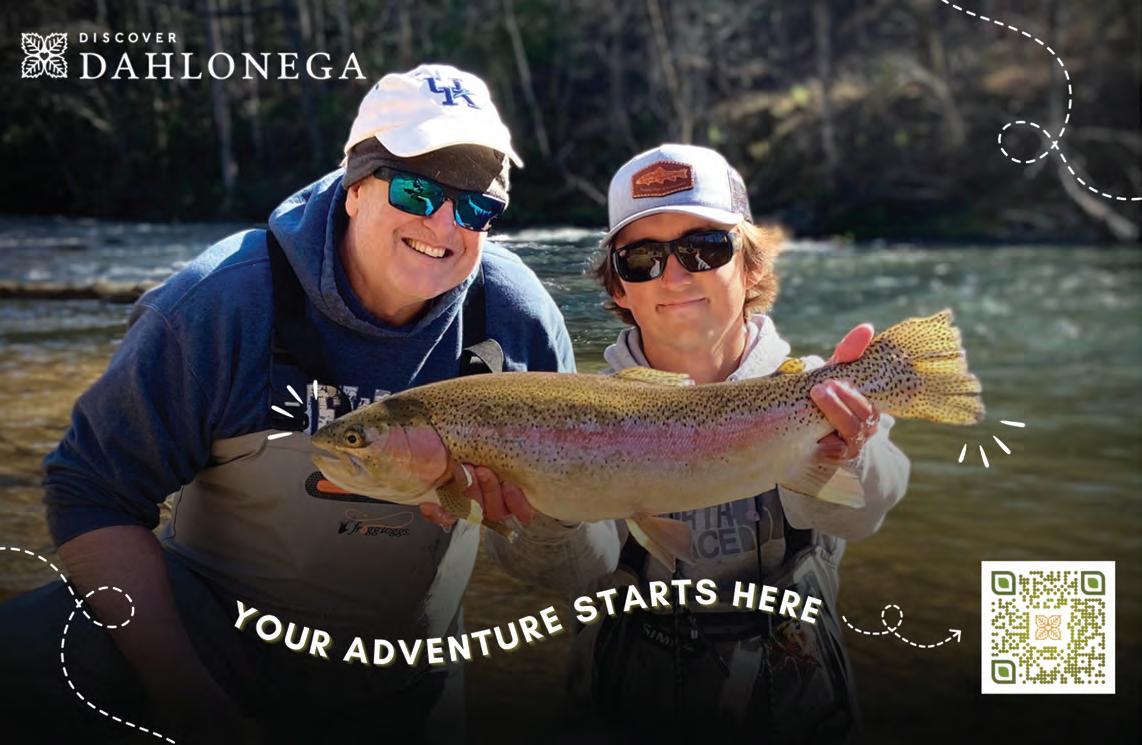
GATLINBURG, Tenn.— Newfound Gap Road is getting an upgrade! Starting July 14, Great Smoky Mountains National Park will kick off a rehabilitation of a 7-mile stretch of Newfound Gap Road on the North Carolina side of the park.
The roadwork will include repaving the roadway from milepost 20.90 to 27.90, as well as repaving six primary parking areas along this section.
Visitors will see signs of construction but are unlikely to experience any traffic delays for the first stage of the project. All construction work will take place overnight (7 p.m. to 7a.m.) Sunday night through Friday morning (excluding federal holidays) until August 15. Single-lane closures will be in place overnight.
Starting August 15, construction will take place during the day. The park will share updates on any changes to traffic in early August. This rehabilitation project is expected to be completed by September 30. Visitors are advised to drive with caution and anticipate delays due to single-lane closures during the repaving process.
This project is funded by recreation fee dollars (from parking tags, campgrounds, and backcountry camping) and the Federal Lands Transportation Program. Learn more about your fee dollars at work!
More than 1.5 million vehicles travel on Newfound Gap Road
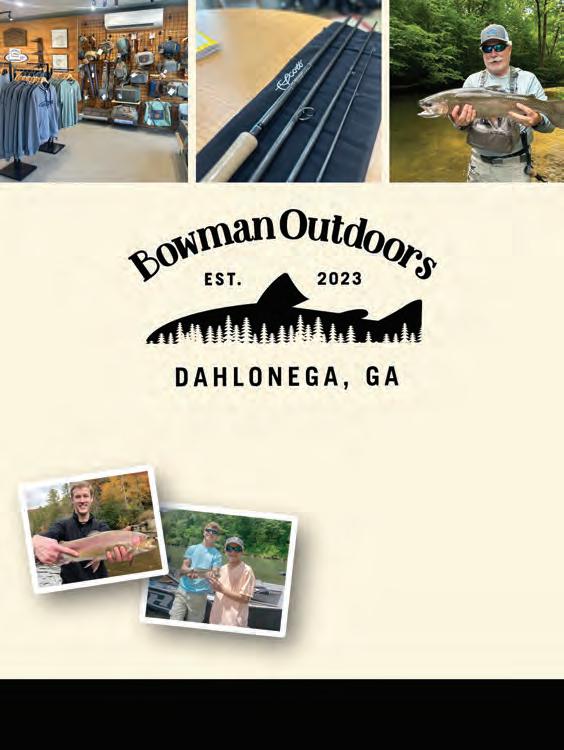


annually.
For more information about temporary road and trail closures at Great Smoky Mountains National Park, please check road conditions before visiting.
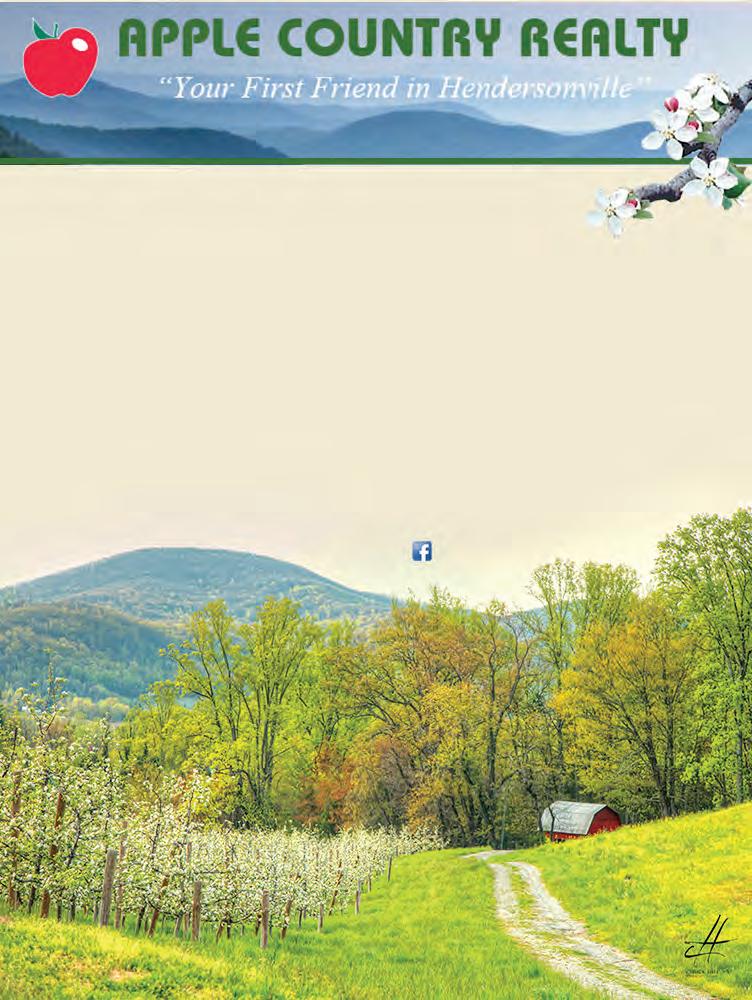
By Daniel Ross, FFC
It all started when Fly Fishing Collaborative’s (FFC) founder asked a simple question: “What do I have in my hand that can do good in the world?” At the time, it was a fly rod, and that question sparked a movement.
Today, FFC builds sustainable aquaponics farms to combat poverty and prevent human trafficking in 11 countries. These closed-loop systems—where fish waste fertilizes vegetables—create year-round food and income with minimal land and water. From remote villages to urban rooftops, they offer practical solutions in places where food scarcity fuels exploitation.
Some farms support safe homes for trafficking survivors. Others are run by orphanages. Many do both. Each farm costs $50,000 to $75,000 to build, depending on location and materials. Some reduce food costs. Others generate revenue through local sales. Often, they do both— producing up to $125,000 in annual value. The goal: long-term, selfsustaining impact. As the old proverb says: “Give a man a fish and you feed him for a day. Teach a man to fish and you feed him for a lifetime.”
But it’s not just about farming—it’s about prevention. UNICEF reports food insecurity is one of the top drivers of human trafficking worldwide. That’s why FFC goes upstream—not just globally, but locally. In the U.S., 60% of human trafficking victims have spent time in the foster care system. That statistic is heartbreaking, but it’s also a roadmap for prevention. FFC responds by hosting one-day fly fishing outings


and three-day trauma-informed therapy camps for foster youth. These experiences offer more than just a day on the water—they create space for healing, connection, and trust.
As one guide said, “Their shoulders start to drop. They begin to relax. That moment of peace is everything.” One camper told her guide, “This
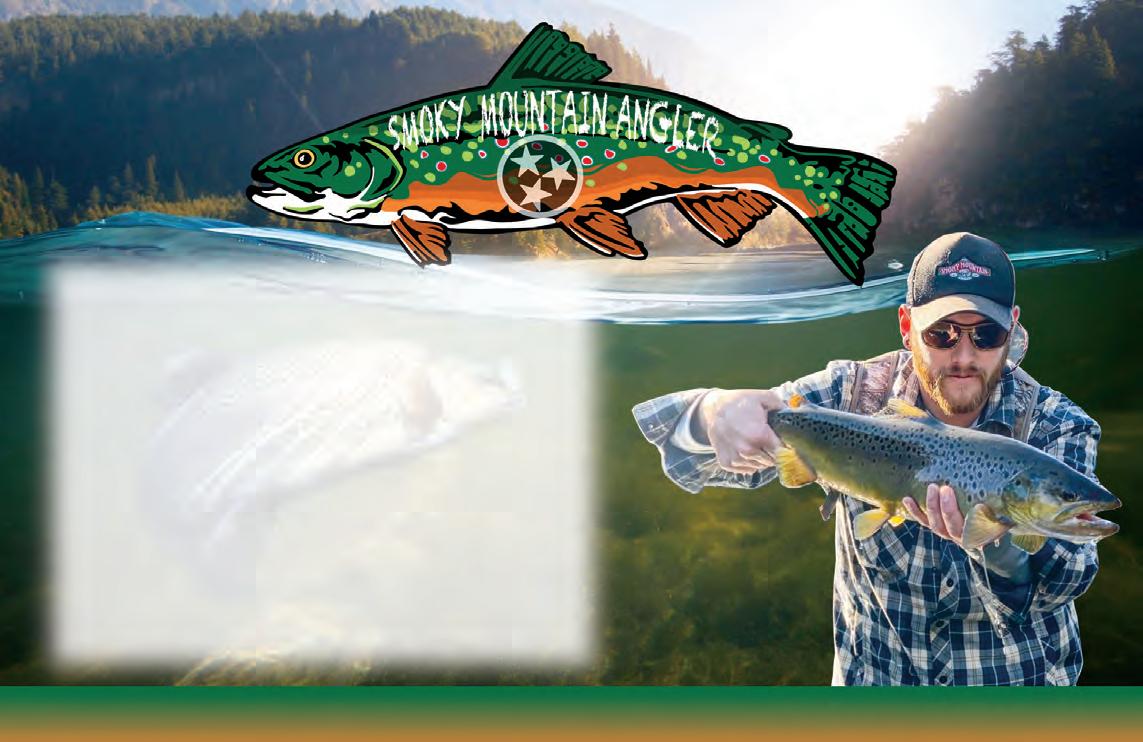
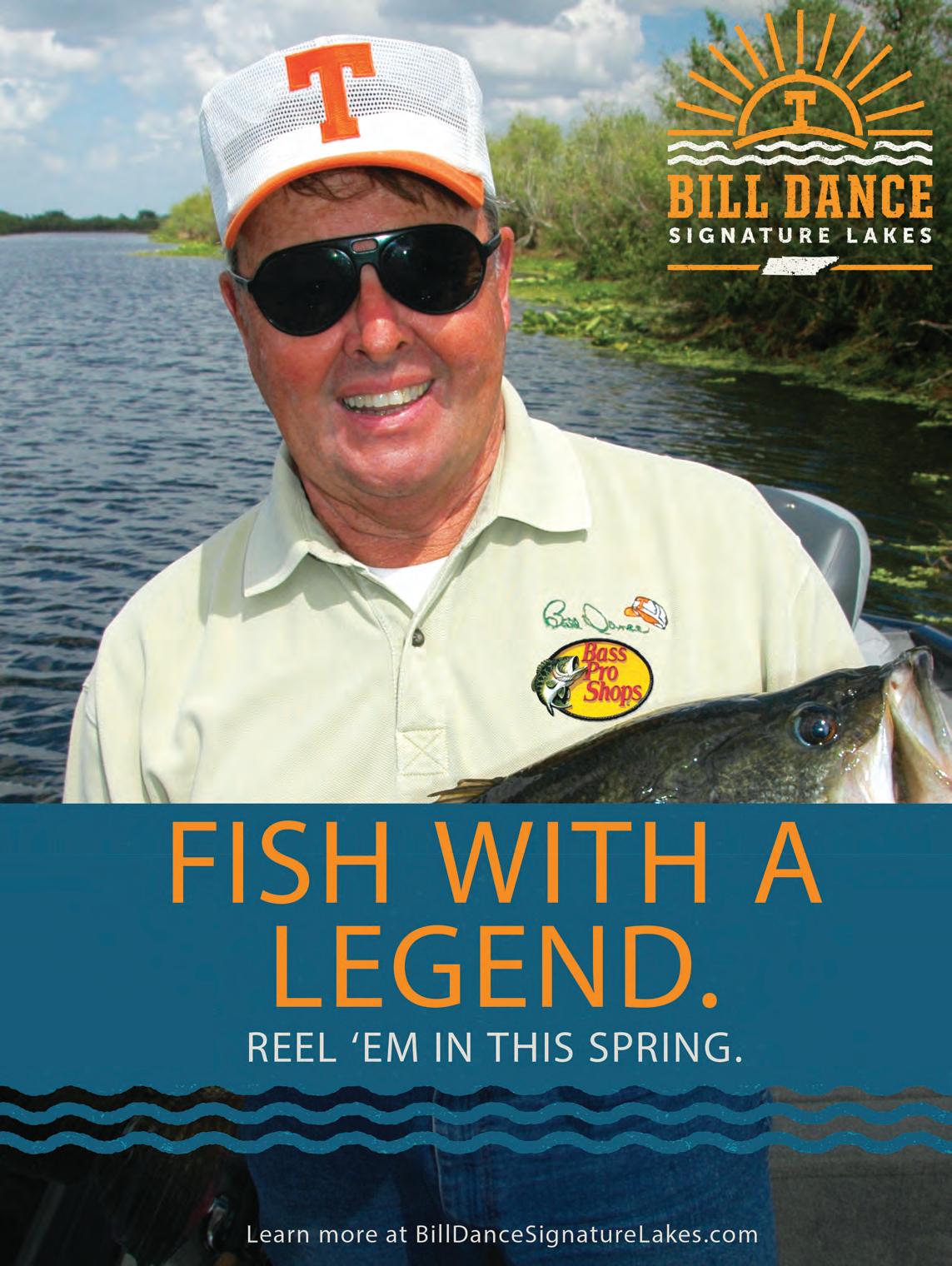
By Andrew A. Cox
Upon reading this article, you have probably had time to experiment with or use some of the gift items that you received as holiday gifts. These may include gifts provided by family members or acquaintances or items that you purchased with the use of holiday gift cards. Most likely, many of these gift items included or involved the use of technology. Hopefully, you were able to master the use of these items successfully. Unfortunately you may have also experienced a great deal of stress in attempting to use these items after gorging on YouTube videos, on-line manuals and similar documents describing the use of these gadgets.
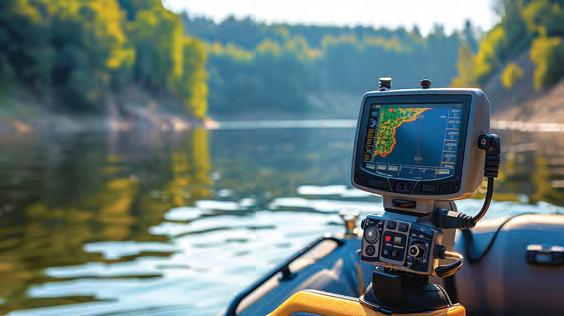
Technology seems to be everywhere in our lives, found at home, work, and in schools. Technology has found its way into the fishing world. Equipment, gadgets, and accessories not available even a few
years ago are fairly commonplace in the angler’s arsenal. Even with this technology, I still wonder if we catch more fish with such technology. It can make fishing more enjoyable or become a source of irritation.
Recently, I talked with an angler at a local reservoir. He had a nice bass boat that was rigged out with a lot of electronic gadgetry. His steering console and the front casting deck of the boat were filled with various television type screens. He demonstrated some of this to myself and my fishing partner. He focused upon crappie fishing on these waters and contended that these devices assisted him in locating and catching this sportfish. I observed him fishing out on the lake and wondered if he spent time fishing or viewing the various screens.

I am old enough and been around angling for long enough to remember the advent of “depth finders” or “flashers”. These were the early prototypes of today’s fish finders and chartplotters. I also remember hand operated electric or “trolling” motors that turned on by twisting the handle, had limited speeds, and had to be operated by hand. Temperature gauges in boats or even hand held temperature gauges are another fishing accessory that I remember coming onto the market.
Trolling motors are now available that self deploy using a remote control sensor device, or optional high tech foot control unit for operation, and an electronic anchoring system that allows you to remain in a certain spot on the water. These motors will also operate remotely through deployment of GPS coordinates.
Fish finders/chartplotters have also made great strides in technology. New generation fish finders allow the angler to establish waypoints so that you can return to desired areas, download maps for specific bodies of water or locations, and save desired fishing locations for future days on the water. Certainly these are more sophisticated than the old “flashers” that simply showed you what was under the boat if you could interpret the flashing lines. Today’s electronics perform functions that I do not even grasp the concept. Such technology takes practice to master.
The rods and reels that we use today have been impacted by technology. Rods now have “micro-guides” and high tech rod blanks that increase sensitivity. Casting reels have sophisticated breaking and drag systems to reduce “backlashes”. Spinning reels have skirted spools to reduce “birdnests” and been modified for the use of braided line.
Boating equipment has also evolved. The angler can purchase a multitude of boat accessories. The “PowerPole” technology has revolutionized boat operation and maneuverability while fishing.
Some readers may remember the introduction of the internet. The internet now provides a wealth of fishing information. The angler can locate and download information regarding a fishing location to include proven fishing techniques and tactics, water access, and what to expect on a particular body of water. YouTube has a wealth of information on casting and specialized angling techniques, as well as niche topics such as fly tying and lure and rod construction. We can become expert anglers in a fraction of the time that was required through the trial and error approaches of the past. The internet and particularly YouTube content can be of great assistance in mastering your new fishing items or gadgets received as gifts during the recent holiday season.
I anticipate that technology will continue to exert an influence upon the equipment that we use to enjoy our sport. I wonder what fish finders and electric motors will do in ten years? What specialized gadgets and technology will be on the rods and reels that we use in the future? What accessories will be considered essential on the fishing vessels of tomorrow? Only time will tell. Good luck in using this technology—hopefully it results in better success on the water.
Dr. Andrew Cox is a contributing writer to outdoor publications and newspapers. His writing interests specialize in angling and travel, human interest, and general fishing technique oriented topics. He is a member of the Georgia Outdoor Writer’s Association. He has been fishing the waters of Georgia, Alabama, Tennessee, North Carolina, and north Florida for over forty years. He has also fished the waters of most states within the United States, Canada, United Kingdom, New Zealand, Australia, Africa and several Caribbean islands. He enjoys fresh and saltwater fishing for bass, bream, crappie, trout, redfish, and speckled trout using fly, bait casting, and spinning equipment. Dr. Cox financially supports his fishing habits as Professor Emeritus at Troy University, Phenix City, Alabama. He may be contacted at andrewtrout@aol.com.
FOR FALL continued from page 10
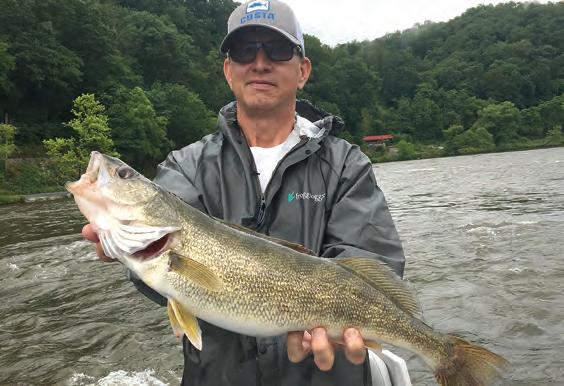
using, but I think the key to success is learning what action the fish want on a particular trip, whether it be a fast or slow retrieve, or jigging it as it works the current.
Knowing where to cast is just as important. Fish are going to hide and ambush prey in certain areas of a pool, so just casting at the same spot will not produce. Mark’s fish was actually spotted before he caught it, as we observed a decent sized trout try to escape it by jumping out of the water. A couple casts later and the rest is history.
Folks, I know it’s hot and can really get uncomfortable, but hit the water early, or right as the cold rains start, and go monster hunting. And as always, take a kid fishing!
Ronnie Parris is owner and head guide of Smoky Mountain Outdoors UnlimitedFontana Lake Fishing Guides, headquartered in Bryson City, NC, 488-9711.
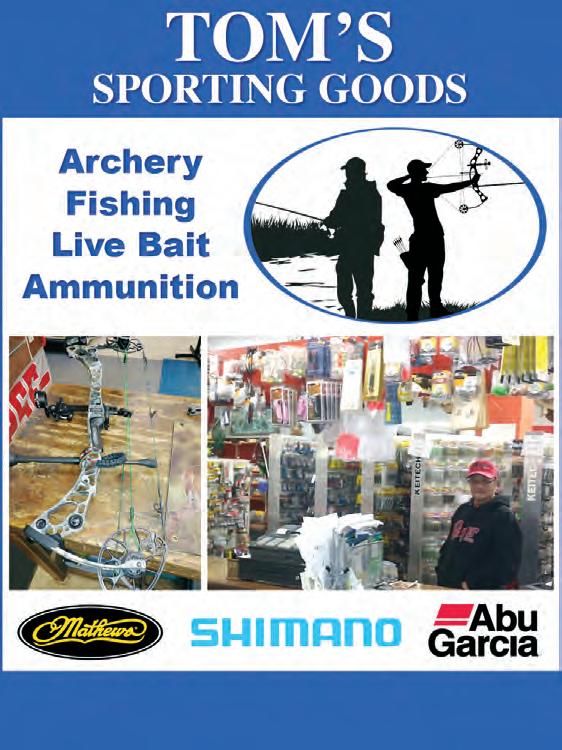
By Perry Hensley
It’s hot and muggy! And those crappies can be tough to catch, right? Well we are going to go over with you some proven tactics to help you catch those crappie during the Dog Days of Summer.
The first method would be the old tried and true method of fishing with minnows. Be it using the Slip Float Method or just tightlining minnows, the first thing to find (and it shouldn’t take long) is bait. Most lakes will have loads of shad/bait schools all over the lake, especially here in the south.
One you have established where the bait is and you have chosen a technique, now it’s time to find a pinpointed location. In my opinion you will need to find some structure under some type of cover or in shade (crappie love shade). Do not rule out shooting docks with artificial baits. Whether its actual shooting docks or dropping a minnow alongside a dock, both have proven to be effective.
Another location would be bridges. Bridges have both structure and cover/shade and a lot of angler night fish under bridges using lights, which will attract the bait, which in turn attracts the slabs (and other fish) to your exact location, so
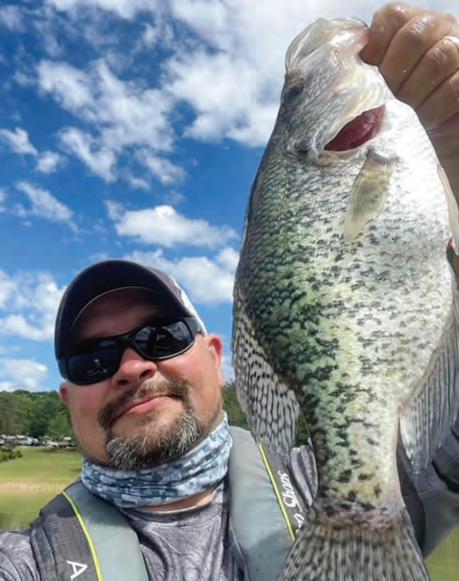

be prepared to catch a catfish, drum, white bass and/or blue gill ! Crappie will choose to hang, in most cases, on the backside of the bridge columns on the current break side, so choose your anchor point accordingly.
Whatever method/technique you choose to fish, or the area you choose, it is important to know also where your thermocline lies in your lake to maximize your attempts to catch a boat load of those finicky summertime slabs.
The absolute best advice that I could give would be to get off that couch and get out there with those you love and make some memories as you enjoy all that our God has given us, and as always, may God bless each of you!
Tightlines,
Perry Hensley Sr.
FINDING RAINBOWS continued from page 12
Bowman Fly Fishing offers both guided and unguided trips on exclusive, trophy-managed sections of the Etowah River and Nimble will Creek, just 15 minutes from downtown Dahlonega. The private season runs from September 20 – June 15, with cooler months offering your best shot at landing a trophy rainbow or brown trout. Bring a heavier rod—you’ll need it.
Recommended Flies
•#14–16 Parachute Adams
•#14 Tan Elk Hair Caddis
•#16–20 Flashback Pheasant Tail Nymphs
•#14–16 Prince Nymphs
•#8–14 Coffee/Brown Pat’s Rubber Legs
•#12 San Juan Worm
•Regulations: Georgia state trout regulations apply. No special lure restrictions.
•Limits: 8 trout per person per day, no size limit.
•Licensing: A Georgia fishing license plus a trout license is required for all anglers aged 16 and older.
Daniel Bowman is the owner and founder of Bowman Outdoors and Bowman Fly Fishing, based in Dahlonega, Georgia. He has spent the past decade guiding anglers across North Georgia, North Carolina, and East Tennessee, and has been operating Bowman Fly Fishing since 2017. In late April 2024, Daniel opened Bowman Outdoors, Dahlonega’s local fly shop—a long-time dream brought to life by his love for the outdoors and sharing it with others. When he’s not on the water with guests or behind the counter at the shop, Daniel enjoys spending time outside with his wife and two kids, hunting in the fall, and chasing fish wherever they swim. His deep passion for the outdoors and the positive impact of time spent outside is what inspires him to share it with others.
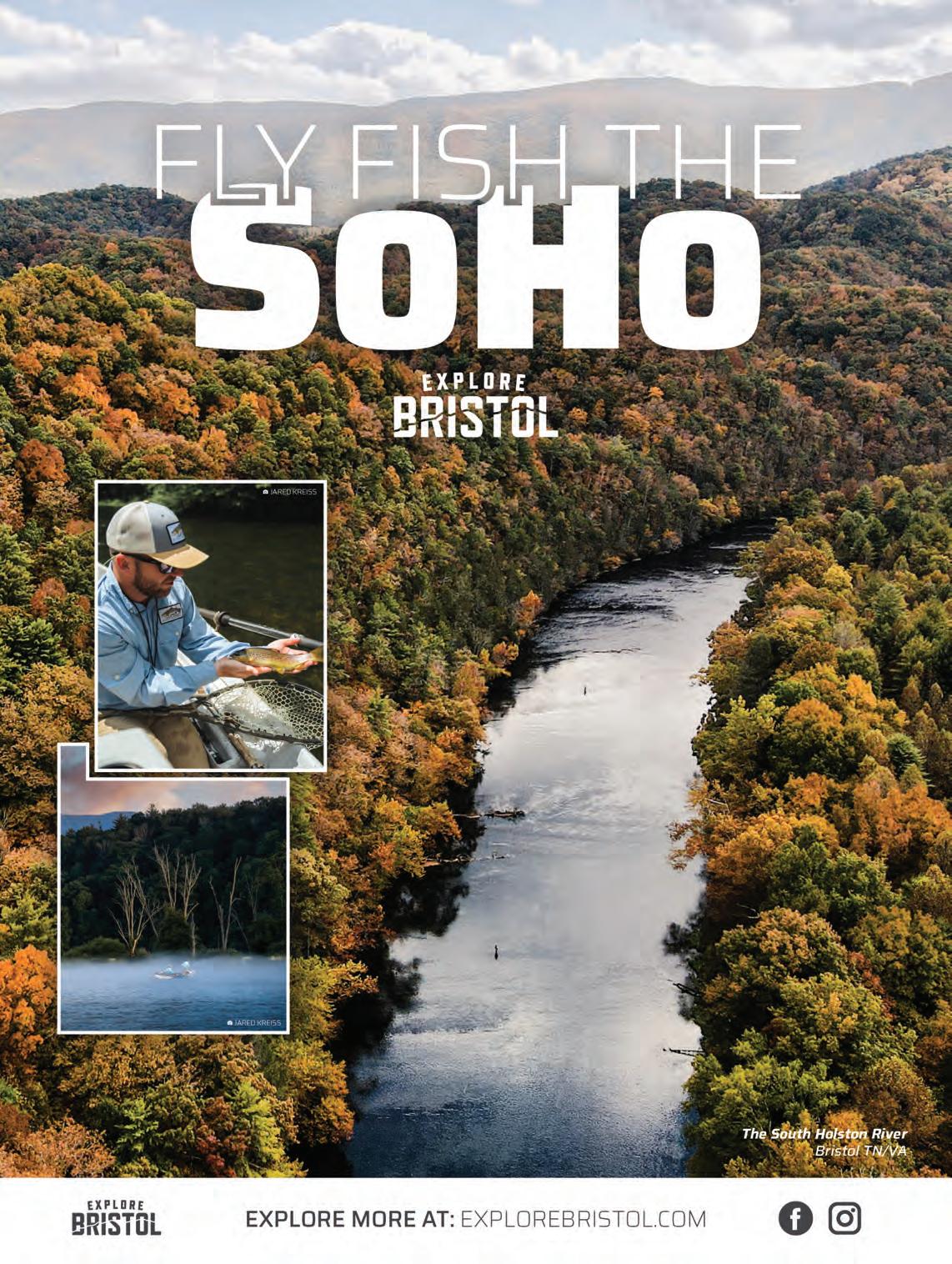
By Scott Norton
We are in the middle of summer and fishing is starting to slow down. Bass at this point are either dealing with being caught, or having to adjust to all the traffic in the daytime. Because of this, anglers will have to adjust with them.
If you are noticing bass not chasing and holding tight to cover, you may need to down size and throw your lures on top of them. Looking for wind and current will help with placement whereas bass will be more active in such an area.
Another way to get in on the action will be the night bite during those full moon periods. You will have a peak window a few days before and a few days after the full moon where they will have the most activity. It makes more sense to fish the nights around the full moon since bass will become more nocturnal due to daytime boat traffic, high water temperatures, and fishing pressure from fisherman.
How does moon phase effect the fish? Well, you will have fish cycles that get kicked off during the full moon phase as well as the forage spawn at these times. When bass get an opportunity to feed at night, the moon will provide those conditions for feeding and chasing to occur. If you fish early in the morning you can catch the tail end of the night bite. After the sun rises, the activity will drop dramatically until the late afternoon hours. The angler will have to slowdown and downsize. You will just want to offer them a snack since they fed up the night before.
This is a good time to use your topwater lures and just cover as much water as you can. If the top water lures are not getting the job done, you will have to go sub surface. Go for chatter baits, spinner baits, worms,
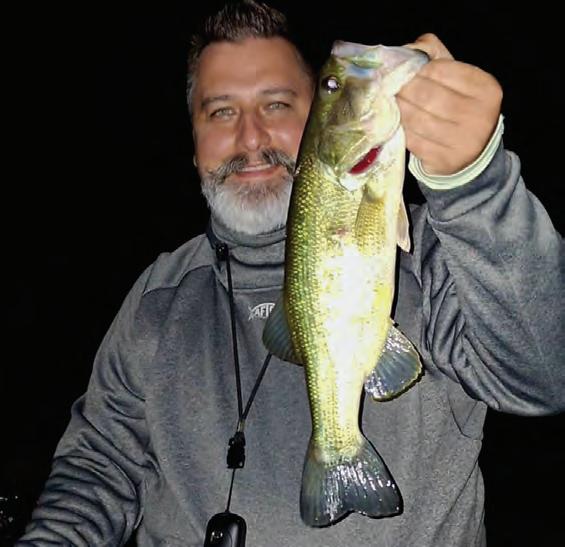
The moon phase will become a thing the warmer the water gets, so give it a try if you haven’t before. Becoming a good angler means you need to change gears when the bite slows down. Enjoy this time! Scott Norton is a Western North Carolina native. Born in Asheville, N.C., he is a long-time hunter, angler and weekend warrior.


FLORENCE, Ala. – The Tennessee Valley Authority and U.S. Army Corps of Engineers will be implementing an interim solution for the guard wall at Wilson Lock to allow normal operations to resume, which will improve lock duration times for commercial vessels, reduce safety risks for workers, and support more than 11 million tons of goods that pass through Wilson Lock each year.
Starting on May 12, TVA began the mobilization of an interlocking system of three ocean barges and equipment to provide an interim guard wall solution to support navigation traffic at Wilson Lock. Each barge is 195 feet long, making the overall length of the temporary guard wall 585-feet-long. This interim solution is designed to last between five to 10 years.
To ensure the barges were ready to be deployed immediately after the Corps finished its repairs and reopened Wilson’s Lock main chamber, the ancillary systems, including lighting, handrails, and electrical components, were installed at a docking area near Pickwick Dam in June.
The U.S. Army Corps of Engineers Nashville District is closing the main lock to navigation July 14-28, 2025, while TVA installs the interim guard wall. USACE will operate and keep the auxiliary lock open for navigation traffic during the installation.
TVA will provide construction management oversight, and our Equipment Support Services Group will provide boat services during positioning and installation of the ocean barges. The U.S. Army Corps of Engineers will be managing lock traffic.
Additional Information:
•On August 31, 2021, the Wilson Lock floating wall that guides boats into the primary lock lost buoyancy, detached, and sank to the bottom of the reservoir. This was a result of impacts from Hurricane Ida. Inspections showed there were no safety or environmental impacts
FISH WELL DO GOOD continued from page 14
is the first time I’ve felt safe in years.” This fall, FFC is piloting outdoor retreats for foster parents. When caregivers are cared for, kids thrive. These getaways offer space to rest, reconnect, and return home stronger for the children who depend on them.
From humble roots in Portland, Oregon, FFC now includes staff in Colorado, Florida, and Italy, with ambassadors across the U.S. and Canada. FFC only partners with local organizations already doing good work—empowering leaders who know their communities best.
Recently, ambassadors Ryan Boggs (Trout Unlimited) and Steve Deblois (Brookside Guides) connected with the Angler & Coastal Angler Magazine team at the Maggie Valley Fly Fishing Festival in North Carolina.
FFC’s ambassador network includes trout guides in the Appalachians, steelhead fanatics in the Pacific Northwest, and flats guides in the Gulf and Tampa Bay. They’re always looking for others—especially guides— who want to host fishing trips that matter.
This fall, FFC and Fly Fusion Magazine will launch the Fish Well. Do Good. Trout Tour—a film series screening in fly shops, theaters, and select Orvis stores across the country. FFC gives special thanks to early tour sponsors Korkers, Orvis, and NRS for supporting the cause.
Launching January 2026: fishwelldogood.com
Sign up now to be the first to hear about epic fishing trips that give
to the dam.
• TVA and the U.S. Army Corps of Engineers have been collaborating on this issue since day one to ensure impacts to navigation and the industry are minimal. Up until the closure of the main lock in September 2024, TVA’s Equipment Support Services Group provided boat support to commercial vessels to maintain navigation traffic.
•While the interim solution is in use, TVA will continue to collaborate with various partners to seek funding for a permanent floating wall that mirrors the design of the original solution and includes modernized features.
The Tennessee Valley Authority is the nation’s largest public power supplier, delivering energy to more than 10 million people across seven southeastern states. TVA has one of the most diverse energy systems –including nuclear, hydro, solar, gas, and advanced technologies. To prepare for the future, TVA is making significant investments in its power system toward new generation and transmission.
TVA is a corporate agency of the United States, receiving no taxpayer funding, deriving virtually all of its revenues from sales of electricity. TVA maintains some of the lowest energy costs and highest reliability in the nation. TVA’s retail rates are lower than 80 percent of the rest of the nation, while its industrial rates are lower than 95 percent of the top utilities. In addition, TVA provides flood control, navigation, and land management for the Tennessee River system, and assists local power companies and state and local governments with economic development and job creation.


back, ways to make a difference locally and globally, and exclusive merch available at tour stops. You’ll also be able to find a Fish Well. Do Good. film tour stop near you.
Go to fishwelldogood.com and join the movement. To learn more about the broader work, visit flyfishingcollaborative.org.
Fish Well. Do Good.
#FishWellDoGood
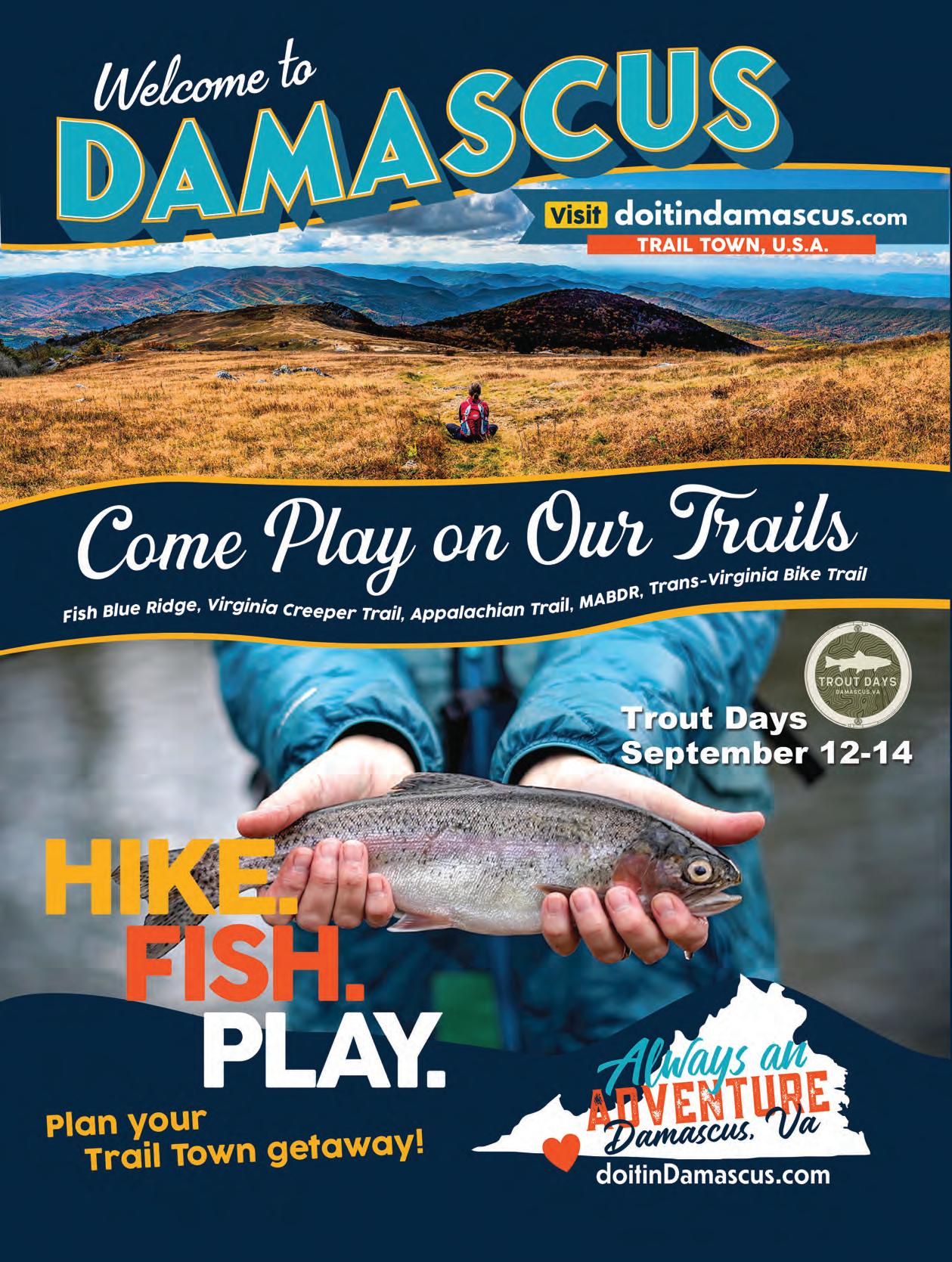

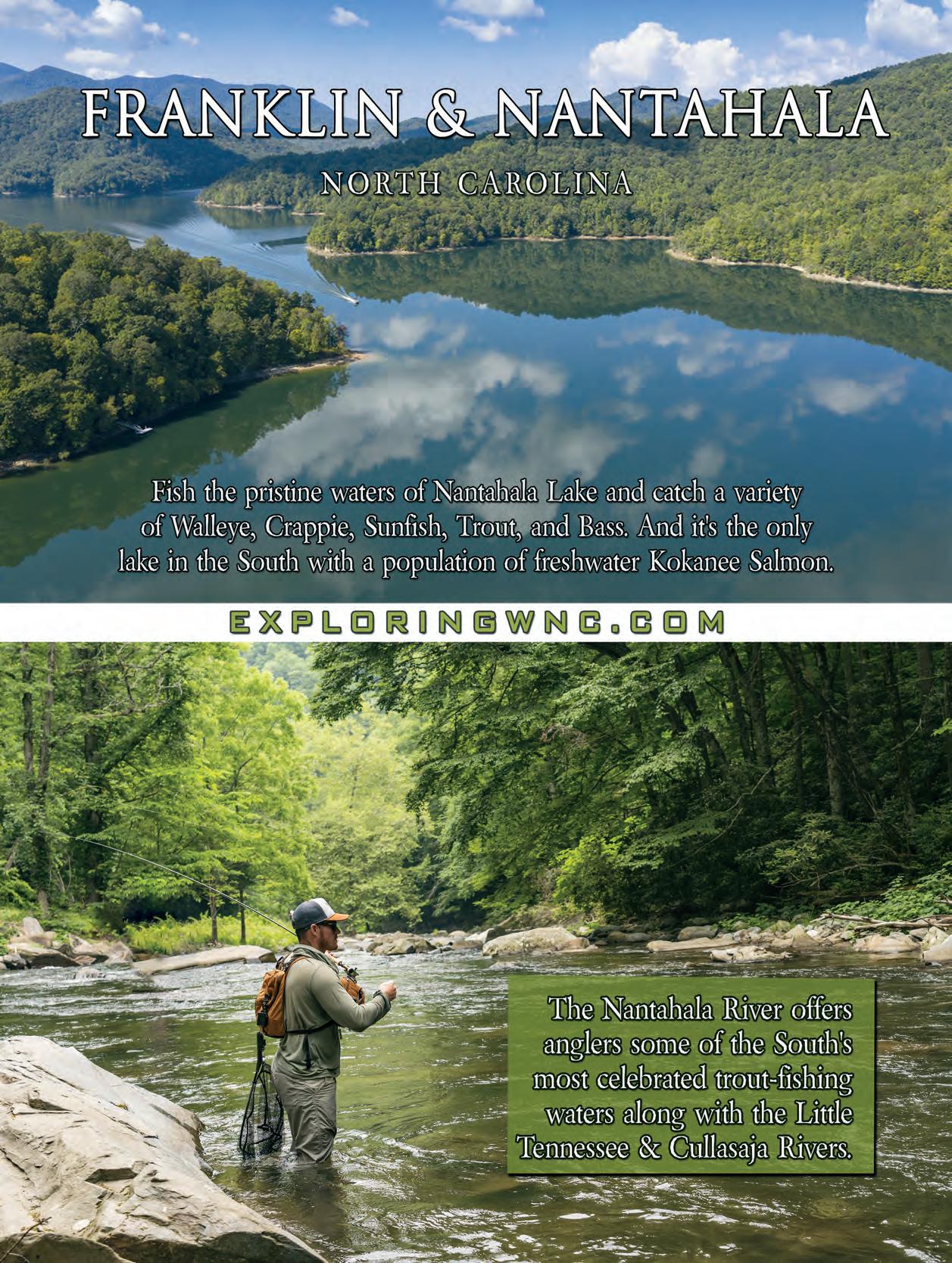
It’s no fsh tale when you run with a John Deere. You can get everything done faster and easier, so you get more time on the water. Plus, our special offers make them the catch of the day.



The boating industry is jumping onboard with Dometic’s revolutionary DG3 Gyrostabilizer, due to its groundbreaking spin-up and spin-down times, energy e%ciency and superior performance in all types of sea conditions. is solution has literally taken vessel stabilization to a “Whole New Level,” capturing the attention of boaters and boat builders around the world. e !rst in a planned line of advanced stabilization solutions by Dometic, the new DG3 is targeted at the 35- to 41-foot !shing boat market.
Soon a er Dometic won the 2025 NMMA Innovation Award at the Miami International Boat Show for the DG3, leading American boat builder Regulator Marine announced that its new-for-2025 Regulator 35 Center Console would be o ered with Dometic’s DG3. “We are honored to have a respected builder like Regulator come onboard,” said Dometic Marine Segment President Eric Fetchko. “ eir latest center console agship is an ideal match for our system in terms of size, hull performance, overall quality and a wide range of premium features and technology. It’s also a wonderful platform to showcase our advanced capabilities, including energy e%ciency that enables o shore use without the need for an onboard generator,” added Fetchko.
e DG3 reduces spin-up time by more than 65%, reaching full readiness in just 16 minutes, compared to the typical 50 minutes required by current systems in the market. is means you’ll
get out on the water and out to distant !shing grounds faster. e system’s downtime is equally impressive, fully lowering in just 20 minutes, a signi!cant improvement over the eight or more hours (15X faster) required by current systems.
Dometic also pioneered innovations in energy storage and recapture, enabling the battery to recharge e%ciently. DG3 uses Dometic’s proprietary, industry-proven Inverted Roller Screw technology for true dynamic control and signi!cantly improved roll reduction performance over a wide range of sea sates. In addition, the push-pull motion of Dometic’s all-electric procession actuator is used to create power that contributes to running the system. During spin down, Dometic’s regenerative braking technology recharges the system’s dedicated 48V Lithium-Ion spin-up battery for the next use. Overall, the DG3 reduces power consumption by an impressive 40% compared to other gyros on the market.
DG3’s Inverted Planetary Roller Screw technology and proprietary all-electric procession actuator provide dynamic control of the gyro hemisphere for instant response to vessel movement and superior comfort over a full range of sea states. is allows DG3 to react faster to heavy wave motions, while also smoothing the ride in small and long period waves, where current gyros are less e ective.
Durability and reduced maintenance were also key goals for Dometic engineers. Dometic’s


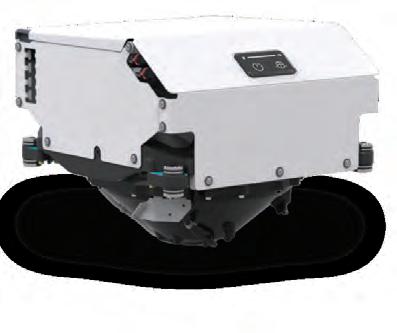
durability, minimizes required service, and reduces total cost of ownership. Featuring a slower-spinning ywheel, larger, more robust bearings, patentpending inner race cooling, parallel path cooling, and a titanium heat exchanger, the DG3 is designed to stay cool and operate reliably for the long run.
Dometic designed the DG3 as an easy “dropin” replacement for other comparably sized systems available in the market today. e DG3 !ts within the same footprint and clearance speci!cations and features reversible mounting feet to address common challenges encountered by installers. To meet the needs of today’s boating market, Dometic’s DG3 is compatible with 12-, 24- and 48volt house battery systems.
To learn more about how Dometic’s DG3 can take your o shore shing adventure to a whole new level, visit www.dometic.com.





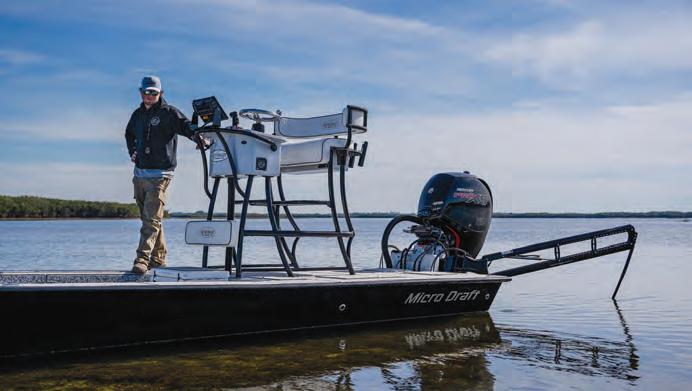




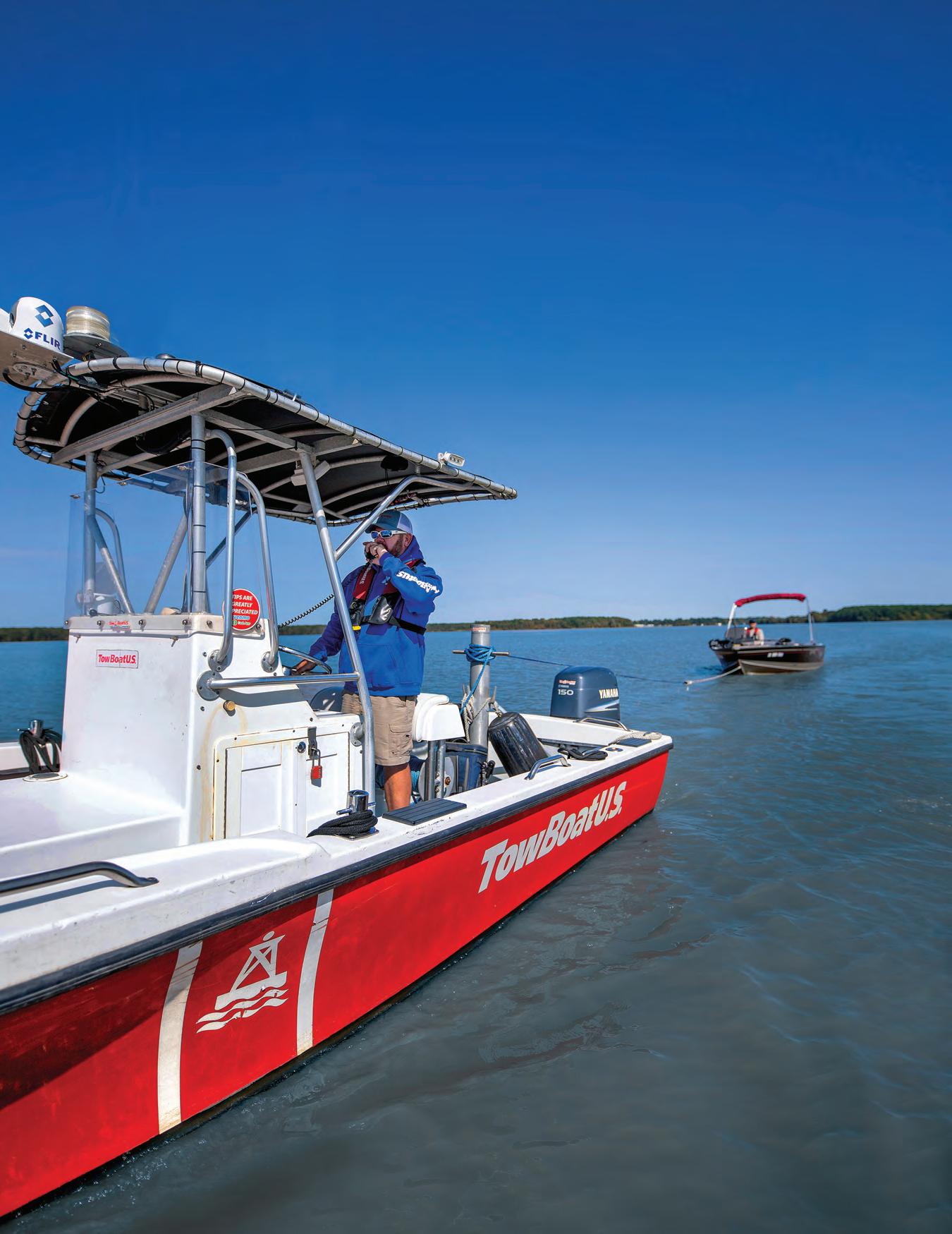



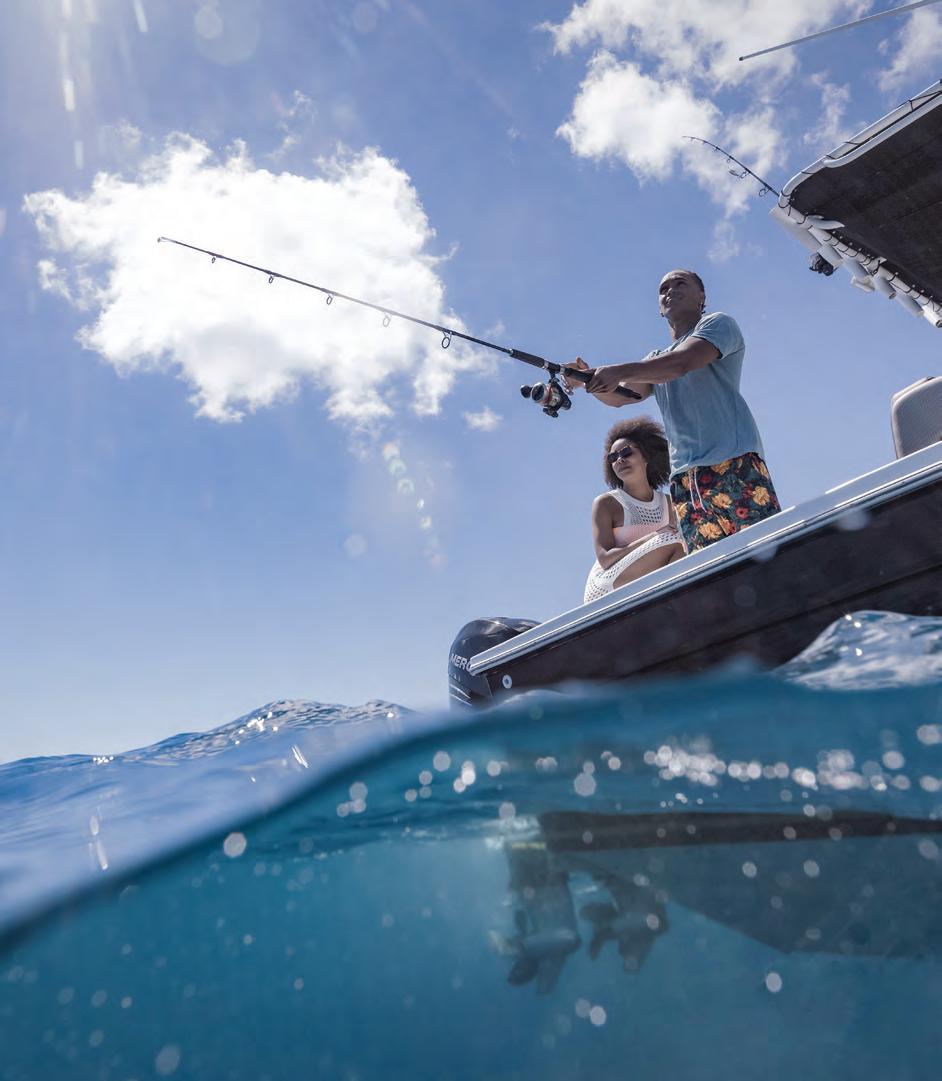
Nestled in the heart of the Caribbean, the US Virgin Islands embody a harmonious blend of natural beauty, cultural vibrancy, and laid-back serenity. ese islands are more than just a picturesque getaway; they are a living testament to nature’s rhythm and resilience, e ortlessly in tune with the world around them.
With no passport required for U.S. citizens, from the moment you arrive, the islands’ natural rhythm is palpable. e gentle sway of palm trees, the soothing sound of surf crashing against sandy shores, and the vibrant melodies of local music all echo the heartbeat of this tropical paradise. e islands’ lush landscapes, with their verdant hills and crystal-clear waters, mirror the steady pulse of life that sustains the local ecosystems and communities alike.
e US Virgin Islands’ environment is a symphony of biodiversity with world class shing and diving. ese natural elements are not static; they dance in harmony, in uenced by the tides, wind, and seasonal changes—further emphasizing the islands’ intrinsic rhythm. is delicate balance underscores the importance of conservation e orts, ensuring that future generations continue to experience the islands’ natural cadence.
Culturally, the US Virgin Islands are equally in tune. e music, dance and festivals re ect a vibrant heritage rooted in African, European and Caribbean traditions. e spirited calypso beats
and reggae rhythms are expressions of life's ongoing dance—celebrating resilience, community and joy. ese cultural expressions are an extension of the islands’ natural rhythm, showcasing how human life here moves seamlessly with nature’s ow.


In a world o en dictated by chaos and rapid change, the US Virgin Islands serve as a reminder of the beauty of being in sync with nature’s tempo. eir natural, cultural and ecological rhythms o er
a blueprint for sustainable living and harmony. As travelers and residents alike continue to embrace this rhythm, they uphold a legacy of balance—one that celebrates life’s natural ow and the enduring spirit of these remarkable islands. In the US Virgin Islands, being in rhythm isn’t just an ideal; it’s a way of life.

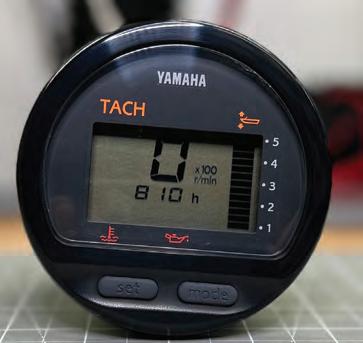

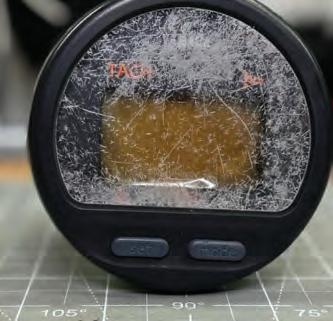


In some parts of the country the bass spawn is already starting to come to an end like it is down here in Florida and others may not start up for another couple months. Regardless of your phase, this post spawn !shing tip should help you dial in your !shery when the time is right for you! One thing is the same for every !shery and every species of bass a er they spawn, they are hungry! is can create some awesome and fun !shing opportunities that have led me to some of my best days on the water.
Typically a er the largemouth bass spawn, there are other !sh that will then begin their spawn. I’m not a scientist, but I’m sure this has a lot to do with the speci!c timing of why the bass do their thing when they do. In most areas of the southern United States, I know that the bluegill and o en times the shad, if they are in your lakes, will start to spawn very shortly a er the bass !nish up. Bass will use every advantage they can when these bait!sh group up to feed back up a er a long couple weeks or months protecting their eggs in the shallows and this can make for some fun !shing.
Smallmouth bass and spotted bass are very similar as well in the aspect of taking advantage
TYLER WOOLCOTT

of bait schools when they get in that post spawn phase. I have seen them group up and attack shad, perch, alewife schools and any other bait that is readily available to them. Typically I do a lot of my searching for these things with my electronics and forward facing sonar which is a very helpful tool for learning !sh activity and seeing what’s going on under the surface of the water.
Most of the time you can use clues you can visually see with your eyes to help you !nd this feed that is going on. Typically birds feeding on the water is an awesome sign of a feeding frenzy and that is one thing I ALWAYS look for. Also always keep your eyes peeled for !sh blowing up on the surface or shad ickering as well. Sometimes the very smallest clue can lead you to much larger picture. Birds standing on speci!c banks, the sound of bluegill popping around vegetation, anything that clues you in to bait in the area usually means the bass aren’t very far.
Hopefully this tip will help you when the !sh in your area get into the post spawn feed! Find the bait, you will !nd the bass! I always try to duplicate the bait!sh with whatever kind of lure you are throwing. Bluegill eaters - I will
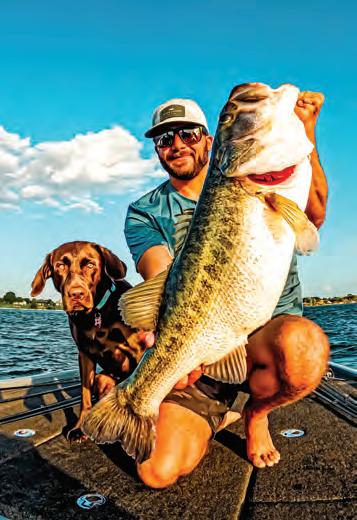
throw a frog or a swimming in bluegill colors, etc. Shad eaters - I will throw white or silver topwaters and crankbaits, etc. Always match the hatch if possible! Good luck out there this season and tight lines!
Tyler Woolcott is a professional tournament angler and guide. Check out his website at www.tylerwoolcott shing.com.


“I never expected it to be so beautiful that it takes your breath away.”
— Kaya C., on Stauer Opals
In a quaint village, nestled between rolling hills, lived a young woman with a deep appreciation for gemstones. Her grandmother gifted her a delicate cross pendant adorned with opals. "e opals shimmered with a mesmerizing play of colors, reflecting hues of blues, greens, and fiery oranges. Her grandmother shared the legend of the opals, believed to bring hope, purity, and luck to those who wore them.
Using this story as inspiration, Stauer brings you the Opal Spirit Cross Pendant. With over 2 total carats of Kyocera lab-created opals set in .925 sterling silver encased in yellow gold, this pendant is a radiant celebration of beauty and craftsmanship. Each opal captivates with a kaleidoscopic dance of fiery oranges blending into oceanic blues, streaked with flashes of vibrant green that seem to come alive with every movement. "e shimmering opals are skillfully arranged to create an enchanting, otherworldly glow, embodying the spirit of hope and harmony.
"is breathtaking combination of color and craftsmanship is available as a limited availability of

only 930 pieces, making it a rare and treasured addition to your jewelry collection. Plus, when you order today, you’ll receive the gold-!nished sterling silver chain—a $69 value—absolutely free!
Don’t miss your chance to own this exclusive tribute to timeless elegance and meaningful symbolism. Necklace Speci!cations:
• 2 ½ ctw. Kyocera lab opals and DiamondAura® accents
• Yellow gold-finished .925 sterling silver setting
18"
silver



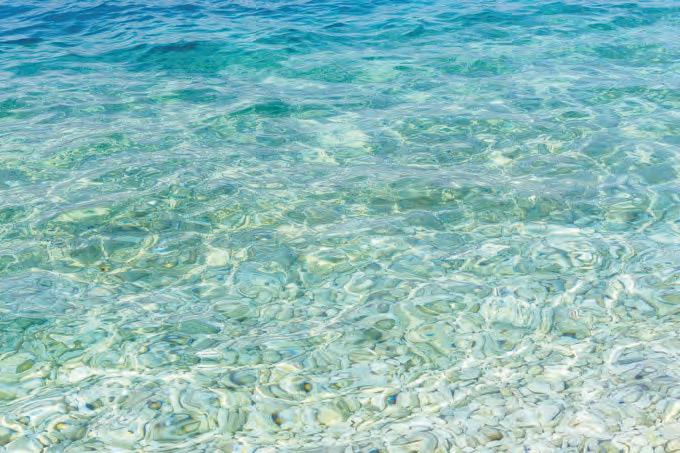







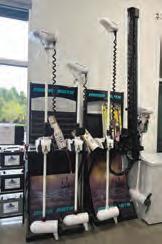

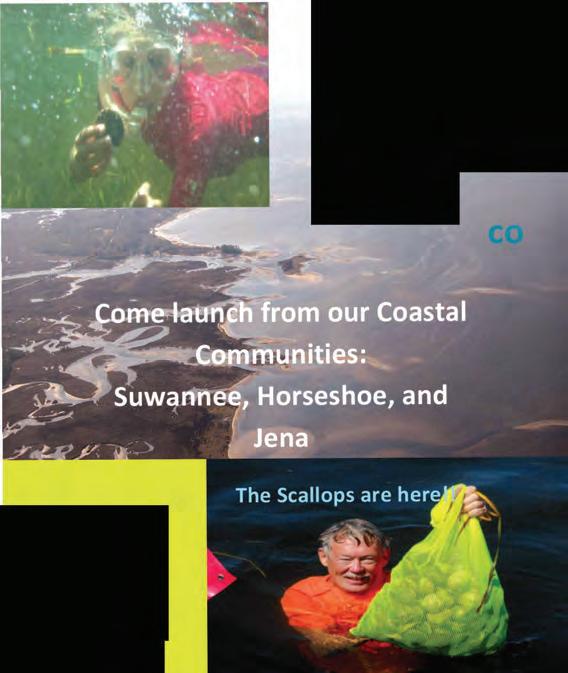



The quest to find the ultimate men’s watch has traditionally been a difficult one in the world of fashion. A timepiece with the perfect look and functionality has long been the goal of both watch designers and enthusiasts alike.
The Renegade Blue Chronograph Men’s Watch is the perfect combination of style and function. With a sleek design that features a bold blue dial, rose gold hands and hour markers, and a durable sports silicone band, this timepiece will instantly elevate any outfit.
The three sub-dials provide a precise timekeeping function. The sports silicone band is durable yet comfortable, providing a secure fit that won’t slide around on your wrist. The band is also easy to clean and maintain, making it perfect for everyday wear. The watch’s 30 Metre Water Resistance rating ensures that it has you covered whatever the occasion.
The Renegade Blue is also built to last, with a sturdy stainless steel caseback and exquisitely detailed bezel. The watch is powered by a super reliable quartz movement, which is covered by our incredible 5 Year Movement Warranty - ensuring accurate timekeeping for many years to come!



At the amazingly low price of just $99 plus S&H, this watch is an absolute steal. Don’t miss out on the chance to own the Renegade Blue and Rose Gold Chronograph Men’s Watch - order yours today!




